

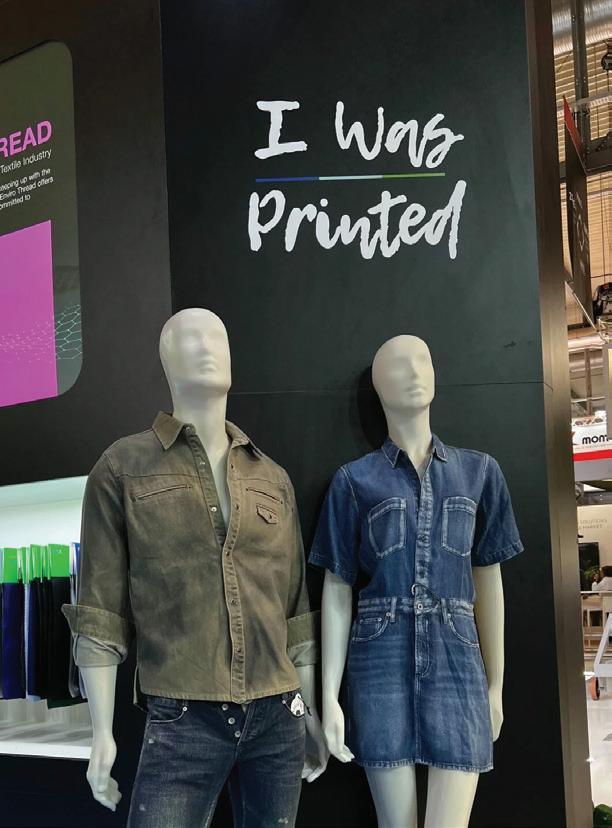
FIBERS, FILAMENTS & PROCESSING SOLUTIONS ifj.com Issue 5 2023 RECYCLING and Color INDUSTRY 4.0 Frameworks & Technologies for Recycling and Broad Use of Biobased Materials MEDICAL TEXTILES Extending Health and Profits FIBERS Industry Challenges to Sustainable Fiber Production Hygienix ITMA Asia SHOW PREVIEWS: What’s Trending at ITMA

THE SHARP CUT TO MORE EFFICIENCY. HIGH PERFORMANCE BLADES AND STATE-OF-THE-ART-COATING FOR SUPERIOR CUTTING RESULTS IN STAPLE FIBERS.
100% MADE IN SOLINGEN · GERMANY!
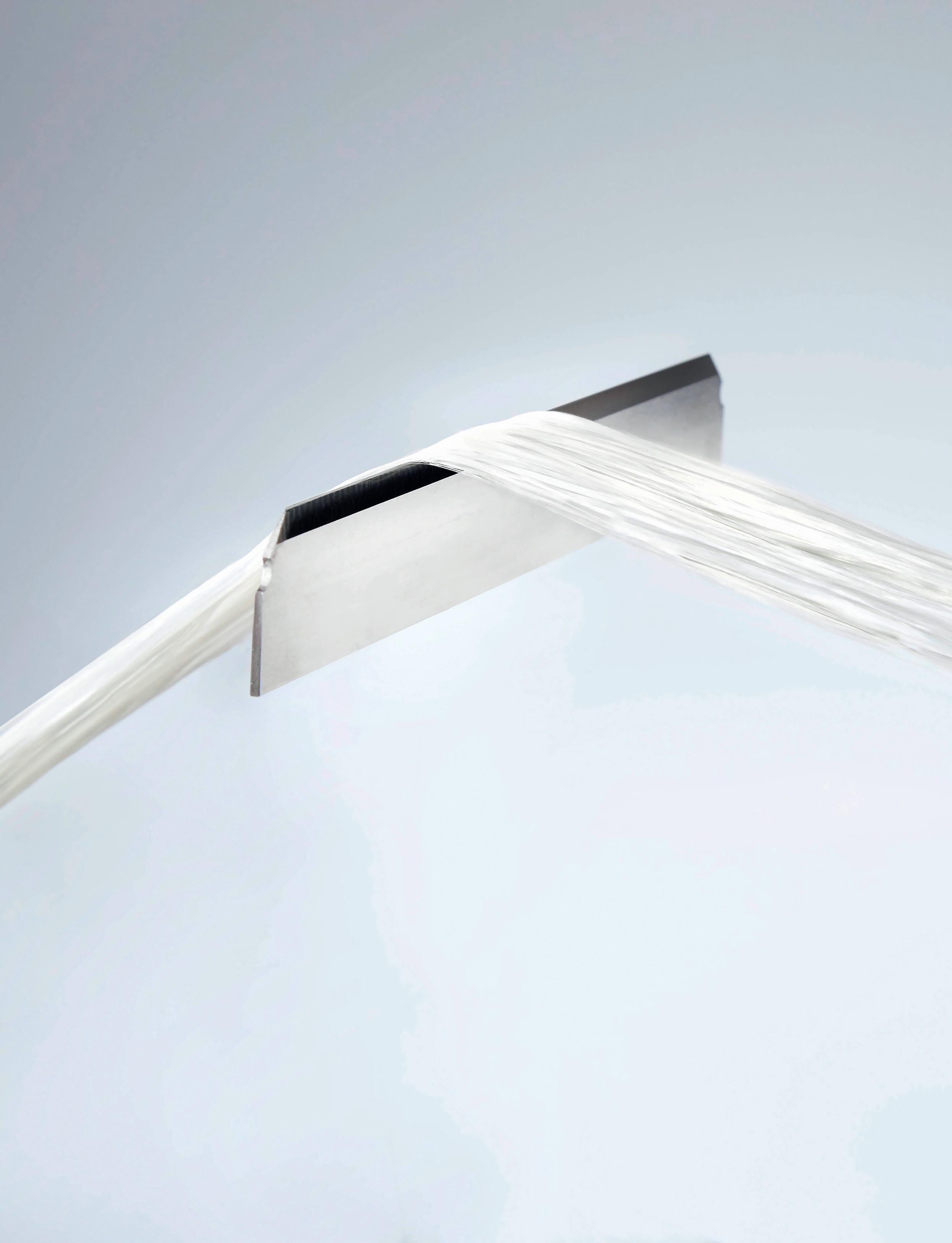
100% MADE IN GERMANY Distributed in North America, UK and Mexico by Fi-Tech www.fi-tech.com MOZART AG Solingen/Germany mozart-blades.de SHARP
EVERY DETAIL!
IN
CONTENTS
FEATURES
14 10 18
CEO Q&A: Focused On PSF Growth
Q&A with BP Sultana, Joint President, Ganesha Ecosphere Ltd, India
By Arun Rao
Solution Center: Chase Machine
Fi-Tech
Promach
Showcasing solutions for success

Digital Color & Textile Recycling –Innovation Super Stars
By Caryn Smith, Chief Content Officer &
Defining Cotton Recycling at the Next Level

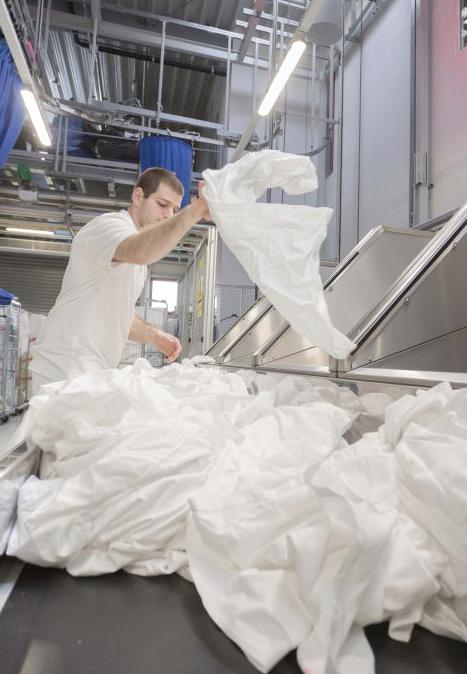
18
Publisher, IFJ
By Adrian Wilson, IFJ International Correspondent
From Industry 4.0 to Research 4.0
By Steffen Müller-Probandt, José Canga Rodríguez
Industry Challenged to Develop More Sustainable Fibers
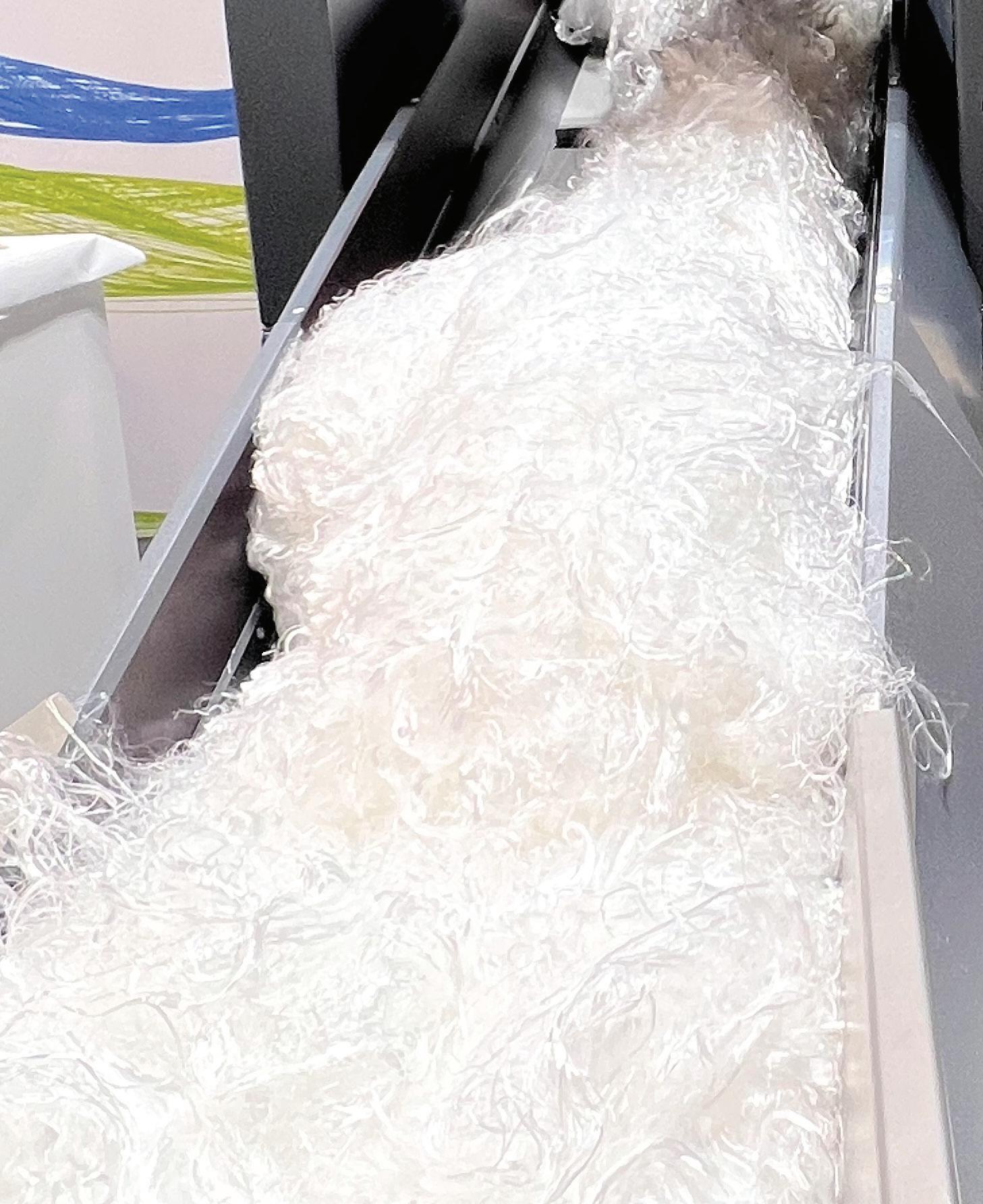 By Geoff Fisher, European Editor, IFJ
By Geoff Fisher, European Editor, IFJ
Devices That Can Extend Health and Profits
By Marie O’Mahony
Preview:
It’s Getting Real: Circular Economy
Discussed at Hygienix™ 2023
Preview:
ITMA ASIA + CITME is On Target for a Large, Vibrant Show
COLUMNS & DEPARTMENTS
6
Viewpoint Choice Comes at a Cost
By Caryn Smith, Chief Content Officer & Publisher, IFJ
Tech Spotlight
Trützschler’s TCO 21XL: 12 Heads Boost Production
Tech Notes
New Technology Briefs
Tech Talk
Advanced Textiles Moving Forward

By Seshadri Ramkumar, Ph.D., Nonwovens and Advanced Materials Laboratory, Texas Tech University
M&A Insights
Avoiding Common Traps and Mistakes When Deciding to Sell Your Company in a “Recession”
By Len LaPorta, Managing Director of Investment Banking, Wiley Bros.-Aintree Capital, LLC
Movers & Shakers Industry News and Notes
2 IFJ ISSUE 5 2023
2023 | VOL 37 | ISSUE 05
40 37
On the Cover: Showfloor Images from ITMA Caryn Smith
7 44 46
26
34
30 34 37 40 42 26
8 43
Advanced Global Technology !
ILJIN's Synthetic Textile Facilities Seeks the World's Best
We are making the best synthetic textile facilities through the power of Korea in global competition
Applications
Multi Filament Line(PA, PET, PP, Bi-Component)



- High Speed Spinning(POY, FDY, SDY)
- Micro Fiber Spinning

- Bi-Component Conjugate Spinning
Staple Fiber Line
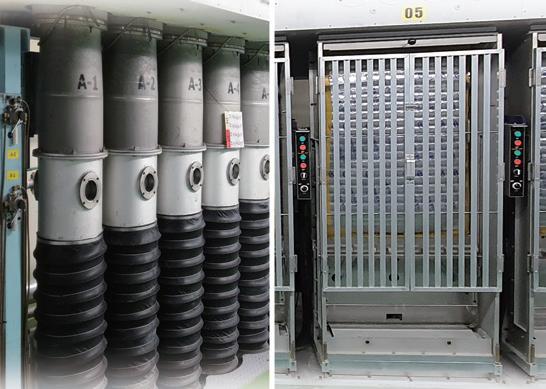


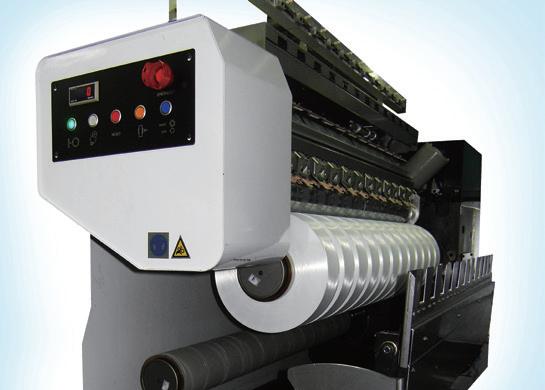
• Industrial Yarn
• Textile Yarn
• Sewing Yarn
• Carbon Fiber
• Lyocell
• Aramid Fiber
• Acrylic Fiber
• Spandex Yarn
www.iljinat.co.kr
pAssion of iLJin ILJIN A-TECH CO., LTD. 49, Saneop-Ro 382 Beon-Gil, Nam-Gu, Ulsan 44781, Korea TEL. +82-52-260-9300 FAX. +82-52-275-0717 MP. +82-10-2844-6234 E-mail. youngha@iljinat.co.kr
Winder
Godet Roller
Spin Beam
Extruder
Take-up Machine
Quenching
Caryn Smith
Chief Content Officer & Publisher, INDA Media csmith@inda.org +1 239.225.6137

Arun Rao India Correspondent, IFJ Owner, Taurus Communications arun@tauruscomm.net
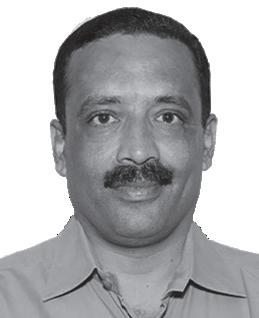

Adrian Wilson International Correspondent, IFJ adawilson@gmail.com +44 7897.913134
Steffen Müller-Probandt
Owner and CEO DIENES Apparatebau GmbH mueller-probandt@dienes.net

José Canga Rodríguez Head of Sales DIENES Apparatebau GmbH j.canga@dienes.net
CALL FOR CONTRIBUTORS
Geoff Fisher European Editor, IFJ gfisher@textilemedia.com +44 1603.308158

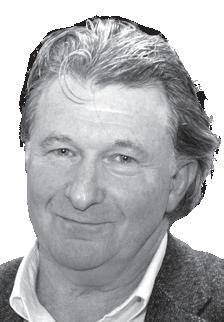

Marie O’Mahony
Visiting Professor, RCA, London https://www.linkedin.com/in/ dr-marie-o-mahony-94776836/

Seshadri Ramkumar, Ph.D. Nonwovens and Advanced Materials Laboratory, Texas Tech University s.ramkumar@ttu.edu

Len LaPorta Managing Director of Investment Banking Wiley Bros.-Aintree Capital llaporta@wileybros.com +1 615.782.4107
International Fiber Journal is seeking contributed technical articles and editorial columns from qualified industry professionals and those allied to the fiber industry. If you would like to pitch an article for publication in IFJ, please contact Caryn Smith at csmith@inda.org.

4 IFJ ISSUE 5 2023 CONTRIBUTORS | ISSUE 5 2023

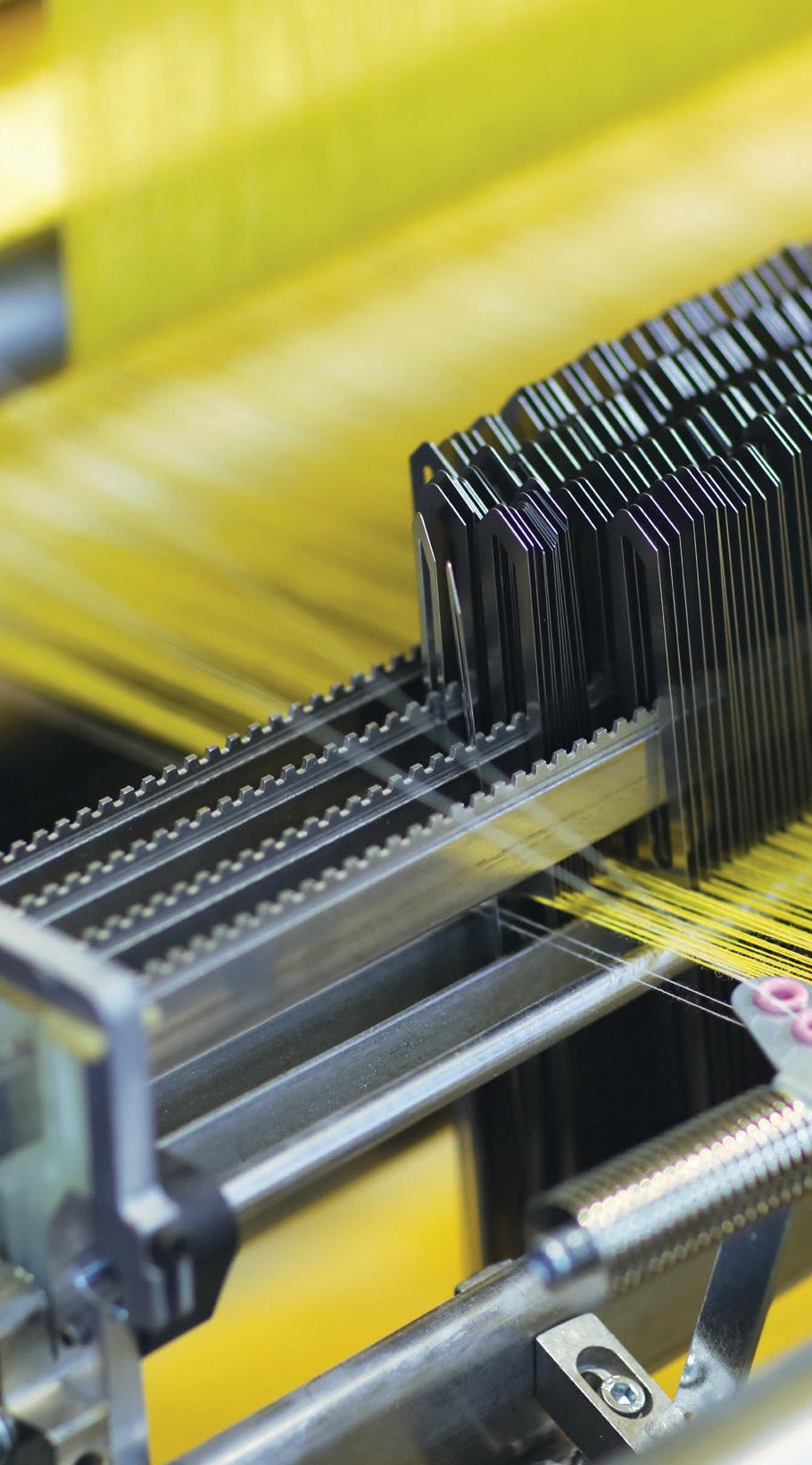

































































CSMITH@INDA.ORG
Choice Comes at a Cost
“Every problem is a gift — without problems we would not grow.”
– Tony Robbins, motivational speaker and writer

The more I learn about the textile industry, the more I am impressed with the collective genius that invents new and interesting options on an ongoing basis – ones I never knew I needed but when I see it and feel it, I must have it. We all make personal textile choices every day, from the interior of a new car that “gets” us, to the jeans we pick out at our favorite stores that make us feel good about wearing them – to furniture, sheets, and more. Textiles offer us a way to express ourselves, as well as bring a level of comfort and convenience to our lives. Economies that can afford it thrive on choice. We want textiles that meet our needs, that are easy to care for, that feel like quality, and that suit our taste.
With technology, it has become easier to push out textile choices at a faster and faster rate. It used to be that fashion collections were offered in the spring/summer and fall/winter. Now, more niche fashion brands change it up five times a year. An article on fast-fashion retailer Zara states that the brand “frequently and quickly updates collections with around 300,000 new different SKUs produced on average every year.”
According to other reports, “The global home textile market size was accounted for USD 124.9 billion in 2022, and it is expected to hit around USD 225.37 billion by 2032, growing at a CAGR of 6.08% during the forecast period from 2023 to 2032.” Also, North America is expected to hold the largest market share due to the high disposable income and the increasing trend of home renovation and interior design in the region. North America is expected to grow at a CAGR of 14.5% from 2023 to 2031.
Wow. Are we getting addicted to choice?
Do I need 300,000 new SKUs to find the
right style for me? Do I need to refresh the decor of my home that often? What are the impacts of all these textile choices I make? Unfortunately, the average person doesn’t ask that of themselves – probably ever. They just act as consumers do, supporting the trends they enjoy through choice.
Well, I think we all know the impacts choice brings. And I won’t rehash them here. What I do want to mention is what I saw unfolding at ITMA 2023 in Milan. If we are to continue in these ways, we must consider the end of life of everything produced. Bit by bit, recycling, sustainability, circularity and specialized textile production were part of conversations, panels and vendor offerings at the show. It was exciting to see the tide begin to turn ... albeit very, very slowly.
Experts, manufacturers, retailers and producers discussed solutions to complex issues. There seemed to be, at the very least, the beginnings of more sustainable textile production methods. Equipment innovation was on display, and what caught my eye is included in this issue. Choices in recycling equipment and coloration of fabrics were significant. And you can read about some of them on page 18. In future issues, I will share more from ITMA Milan.
What I personally walked away with from ITMA Milan was hope. I believe the industry is onto something, and I am excited to be a part of this era of change.
Choice comes at a cost on every level, from the gluttony of consumer choice to implementing industry solutions to adapt to circularity and sustainability, even when the consumer isn’t clamoring for it. Systems, equipment, and mind sets must change.
As we begin to implement new strategies, I believe more will come from it – especially a better environment for our big, small world.
Caryn Smith Chief Content Officer & Publisher, INDA Media, IFJ
Joan Oakley
CHINA Zhang Xiaohua
EUROPE & INDIA Sabine Dussey
ITALY Ferruccio & Filippo Silvera
UNITED STATES Frank Strazzulla
ADVERTISING COORDINATOR Vickie Smead vsmead@inda.org

+1 919 459 3700 x 3720
AUDIENCE | CIRCULATION
CIRCULATION MANAGER inda@stamats.com
+1 800.553.8878
International Fiber Journal is published by INDA Media, the b2b publishing arm of INDA, Association of the Nonwoven Fabrics Industry. +1.919.459.3700 info@inda.media | www.inda.media
INTERNATIONAL FIBER JOURNAL (ISSN: 1049801x) is published bi-monthly by INDA, Association of the Nonwoven Fabrics Industry. Subscription price is $125 per year for non-U.S. subscribers. Periodicals postage paid at Charlotte, NC, and additional mailing offices. POSTMASTER: Please send address changes to International Fiber Journal PO Box 158 Cedar Rapids IA 52406-0158 USA.
MISSION
International Fiber Journal covers fiber-related trends and material science developments and how they impact the supply chain from raw material to end use. IFJ provides thoughtful insights and perspectives to global producers, users and business leaders who need to know about what’s next in fibers, filaments and processing solutions.
6 IFJ ISSUE 5 2023
VIEWPOINT
+1 239.225.6137 CONTENT | EDITORIAL CHIEF CONTENT OFFICER Caryn Smith Driven By Design LLC csmith@inda.org +1 239.225.6137 EDITORIAL & PRODUCTION MANAGER Ken Norberg ken@ifj.com +1 202.681.2022 ART DIRECTOR Julie Flynn EUROPEAN EDITOR, Geoff Fisher INTERNATIONAL CORRESPONDENT, EUROPE Adrian Wilson ADVERTISING | SALES PUBLISHER Driven By Design LLC advertising@inda.media +1 239.225.6137 BUYER’S GUIDE
SPOTLIGHT TECH
Trützschler’s TCO 21XL: 12 Heads Boost Production
For decades, eight combing heads have been considered state-of-the-art in the spinning industry. Now, Trützschler’s advanced technology and engineering proves that it is possible to build a heavy-duty comber that maximizes productivity by 50% and saves space – without compromising on quality.

If two heads are better than one, just imagine what 12 heads can do, the company said. That’s the simple but effective idea behind the TCO 21XL. Increasing the number of combing heads by 50% makes it possible to increase productivity by 50%, enabling rates of up to 150 kg/h. As a result, two TCO 21XL combers offer the same production capacity as three conventional combers. That means companies that buy and operate two machines instead of three can achieve significant benefits in terms of their priceperformance-ratio (cost/kg).

The costs of running the machines are broken down into 12 instead of eight heads, making the machine more cost-effective over its entire operating life. And 50% higher productivity is significant – and it can be even more significant if the machine is operated with JUMBO cans. The can changer needs to keep up with the extra performance, and JUMBO cans can easily collect the additional output of the TCO 21XL because they feature a 1200 mm diameter. This makes it possible to minimize non-productive time when changing cans. Anybody who is planning a new spinning mill knows that every square meter of space adds to the overall costs.
The new TCO 21XL comber offers huge benefits in this regard because 25% less floor space is required to operate the same number of combing heads. This reduces the initial building costs, while also decreasing
operating costs related to lighting, air conditioning and other overheads.
New Function Solves a Major Challenge
As the world’s leading manufacturer of spinning preparation equipment, Trützschler strives to produce reliable and high-quality machines – and also places a strong focus on meeting customers’ needs and continuously improving their products. With this in mind, Trützschler has reinvented their tried-and-tested monitoring system by adding the unique ONLINE NOIL MONITORING function to TCO 21XL. This means the COUNT CONTROL and ONLINE NOIL MONITORING functions are now working together to give customers full control over the combing process and the final yarn quality. Variations in the noil are detected automatically and operators receive a warning if a significant change occurs. In this way, the noil percentage and final yarn quality stay consistent. Material distinctions between different lots are also noticed in real-time, which empowers the operator to act quickly. This can enable big savings in material costs, while also reducing the workload of downstream process steps.
Trützschler Opens a New Chapter in the History of Combing
Why is Trützschler able to build a comber with 12 heads, when eight heads have been considered cutting-edge for so many years? It has been difficult to increase the number of combing heads, and many have tried. Trützschler is the only manufacturer with the necessary technical expertise to open this new chapter in the history of large-scale combing processes. The double-sided drive
concept of DUAL DRIVE and 2TWIN DRIVE ensures the synchronized movement of all machine parts over the entire increased shaft length. During the combing process, highprecision movements are essential to achieve high quality in the sliver. Conventional combers only provide one-sided drives, which lead to higher shaft torsion over the machine width. This might work when operating eight combing heads – but not if adding four more.
High-Performance Drafting System
Twelve combing heads produce 12 slivers, which is a lot more material for the drafting system to handle. Trützschler’s high-performance drafting system delivers a decisive advantage in this respect because it is specifically designed for processing the increased production volumes. The lower deflection angle at the transition to the web guide protects the highly sensitive combed web, fibers are guided precisely and slivers with excellent levels of uniformity are produced. In the wide drafting system, the minimal bearing temperatures of the top rollers make an important positive contribution by enabling lower process temperatures during drafting, as well as optimal running behavior.
www.truetzschler.com
For details on how to submit your company’s technology for consideration as a “Technology Spotlight” in IFJ, contact Ken Norberg at ken@ifj.com or +1 202.682.2022.
ISSUE 5 2023 ifj.com 7
The high-performance comber TCO 21XL.
NOTES TECH
Lenzing Takes Supply Chain Transparency to Next Level
Lenzing Group, a leading global producer of wood-based specialty fibers, is taking an important step in enhancing the transparency and efficiency of the global fiber supply chain with the launch of a pioneering real-time ocean shipment tracker in collaboration with digital supply chain solution company, project44. Adhering to Lenzing’s sustainability goals, the tracker also offers capabilities to improve the visibility of carbon emissions among partners and elevate the customer experience.

To address the industry’s increasing supply chain complexities, Lenzing has incorporated a fully integrated real-time application programming interface (API) between its systems applications and products (SAP) and the project44 platform, Movement. Combined with advanced artificial intelligence (AI), GPS sensors, and machine-learning technologies, Lenzing can now empower customers with accurate real-time insights on fiber orders, ranging from shipment status, container location, to vessel route tracking and estimated arrival times at ports around the world.
www.lenzing.com
Autoneum Unveils Better Acoustic Comfort with Zeta-Light
Autoneum has introduced Zeta-Light, an extraordinary integrated damping function that promises to transform the acoustic performance of fiber-based trim components. This groundbreaking innovation not only delivers unparalleled insulation and airborne noise absorption but also combats low-frequency vibrations in the car body.
Recognizing the importance of components that effectively mitigate both airborne and structure-borne noise within vehicle interiors, car manufacturers have long sought cutting-edge solutions. Autoneum’s Zeta-Light ingeniously meets these demands, offering a unique amalgamation of benefits. The integration of particle dampers seamlessly complements the sound-insulating and absorbing qualities of fiber-based, lightweight, and sustainable technologies like Hybrid-Acoustics ECO+ and Prime-Light, effectively countering low-frequency vibrations in the vehicle body.
One of the remarkable aspects of Zeta-Light is its ability to achieve significant weight savings while simplifying vehicle assembly. With this technology, Autoneum has successfully tackled the challenge of reducing noise and vibration across a broader frequency range, all while significantly lighting the load.
www.autoneum.com
Sonovia’s Dyeing Technology Reduces Pollution in Denim Industry

Sonovia’s ultrasonic technology drastically reduces environmental pollution in the denim industry, according to a comparative study released earlier this month.
The study that took place over the past two months demonstrates that Sonovia’s technology for dyeing denim reduces greenhouse gas emissions by 60 percent, water use by 85 percent, is capable of eliminating up to 99 percent of polluting wastewater, which is a major concern in the fashion industry, and reduces land utilization by 90 percent. Traditional indigo yarn dyeing processes are water intensive requiring on average 60,000 liters of water per process and rely on polluting chemicals such as hydrosulfite.
These findings have not gone unnoticed by industry leaders. The French luxury conglomerate Kering, which owns renowned brands such as Gucci and Saint Laurent, is partnering with Sonovia to install its ultrasonic indigo dyeing technology into their denim production lines. www.sonoviatech.com

8 IFJ ISSUE 5 2023
Lenzing supply chain tracking.
Zeta-Light, an integrated damping function that promises to transform the acoustic performance of fiber-based trim components in cars.
Sonovia uses ultrasonic cavitation jet-streams to effectively impregnate textiles with desired chemistries. Essentially, the jet-streams act as “chemistry guns.”
Benchtop Minitype Spunmelt Nonwoven Lab Equipment from KMD Greenply Produces First Fibers with New ANDRITZ Pressurized Refining System
KMD Plastifizierungstechnik GmbH officially launched the first benchtop Minitype Spunmelt nonwoven equipment at Index2023 in Switzerland this spring, and it has since attracted extensive attention from the industry. KMD continues to upgrade and improve the configuration scheme, optimize the product series, and systematically launch the latest integrated model configuration, which optimizes the mini design of Spunmelt nonwoven equipment & fiber spinning equipment.
KMD Mini type benchtop equipment includes three main categories: Benchtop Spunbond & Melt-blown machines, Benchtop POY/FDY spinning machines, and benchtop extruders. Based on the function of the conventional equipment, the upgraded configuration complies with following design principles:


• Compact design, small size, easy and fast installation;
• Single hole/fewer holes spinneret designs are optional;
• Mono-&Bi-component are optional;
• Very little raw material consumption;
• Integrated & intelligent control, easy to operate;
• Fast test speed, greatly shorten the complex and lengthy R&D cycle;
• Ultra-low energy consumption, friendly to the environment;
• Components and configuration can be customized;
• Economical price, easy to invest.
In order to enable more customers to get convenient services and provide a variety of choices, KMD has recently authorized Triumph Equipment Manufacturing (Yantai) Co., Ltd. to produce several newly launched benchtop spinning machines and Spunmelt nonwoven lab machines in Asia. www.kmd-industrie.de
Greenply Industries Limited has successfully produced its first fibers with its new high-performance pressurized refining system from ANDRITZ at its MDF (medium-density fiberboard) production facility in Vadodara, Gujarat, India.
Sanidhya Mittal, Joint Managing Director, Greenply Industries Limited, said: “The pressurized refining system from ANDRITZ is highly efficient and energy saving, which is in line with our environmentally friendly production process. We would like to thank ANDRITZ and its team for their assistance during the installation and the high level of professionalism throughout the whole project.”
The refining system has a design capacity of 35 bdmt/h and processes wood chips for producing various types of MDF products. It is equipped with a proven S 1056M single disc refiner ensuring highly efficient pre-steaming, low electricity and thermal energy consumption, as well as excellent dewatering in the 20” plug screw feeder.
Greenply Industries Limited, founded in 1984, is one of India’s largest manufacturers of highquality interiors and produces a broad range of MDF products, such as plywood, decorative veneers, doors, and related products. Greenply holds the FSC® certification in forest management. www.andritz.com
AirPerm Air Permeability Tester Redesign Now Allows for PPE Specific Testing
SDL Atlas has released the next generation of its versatile AirPerm Air Permeability Tester. The AirPerm now has test head options specific for testing Personal Protection Equipment (PPE), allowing for Face Mask Testing to EN 14683 and Foam Testing to ASTM D3574 & EN ISO 7231.
Other features of the new AirPerm include:
• Touch screen controller within easy reach
• Test results stored on the main controller and exported via a USB drive
• Automatic ranging system eliminates need for operator interface during a test
• Powerful, yet quiet vacuum accommodates a variety of test plates to suit every application and features easy checks for daily verification
• 20 cm test head comes standard and is used for instrument calibration
• Eight additional heads available
• Side drawers for test head and accessory storage
The AirPerm makes air permeability testing affordable while maintaining confidence that test results meet international and retailer standards for textiles, nonwovens, and paper providing quick, straightforward results in the unit of measure of your choice.
Committed to providing customers confidence in standard based testing, SDL Atlas has offices and experts in the United States, United Kingdom, Hong Kong and China, plus agents serving over 100 countries, SDL Atlas is ready to support its customers with instruments, consumables, and services anywhere in the world.
www.sdlatlas.com
ISSUE 5 2023 ifj.com 9
AirPerm Air Permeability Tester.
Focused On PSF Growth
Interview with BP Sultania, Joint President, Ganesha Ecosphere Ltd, India
By Arun Rao
The demand for recycled polyester staple fiber (PSF) is growing in production of textiles and clothing with each passing day. This is happening due to increased consumer awareness on using apparels produced sustainably. Due to this awareness, various garment brands and retailers like H&M, Target, Zara owner Inditex, C&A, etc. have started using recycled PSF in their garments.

Recently, the European Union (EU) has also introduced a law that by 2030, textile products placed in the EU markets should be long lived and recyclable and to a great extent made of recycled fibers, free from hazardous substances and produced in respect of social rights and the environment.
The nonwovens industry is also expanding all over the world with exponential growth. It has increased by three to four times in the last 10 years, with still lots of scope for growth as nonwoven fabrics have now entered into all aspects of life like carrying bags, baby diapers, wipes, filters and many other products.
International Fiber Journal met with CEO BP Sultania, Joint President, Ganesha Ecosphere Ltd., based in Kanpur, India, on his company’s developments with the PET recycled polyester staple fiber marketplace. Ganesha Ecosphere recycled more than 40 billion bottles in last decade, and that figure is just multiplying day by day. The company focuses on yarn spinning, nonwovens, flame retardant fiber, fiber filling and spun yarn.
IN THIS ISSUE: BP SULTANIA
Joint President, Ganesha Ecosphere Ltd, India

International Fiber Journal: Kindly provide a history about your company.
BP Sultania: India-based Ganesha Ecosphere Ltd. was established in 1988 by Shyam Sunder Sharma, a textile veteran with more than 50 years of experience.
Ganesha Ecosphere was also the first Indian company to set up a PET recycled polyester staple fiber (PSF) plant in 1994 at Kanpur, in the state of Uttar Pradesh, with a small capacity of 4,200 tons per annum.
Initially, there was no awareness about recycled PSF in India among polyester
yarn manufacturers. The biggest challenge before us was to educate and convince customers to buy recycled PSF. It took us nearly 10 years to fully utilize full capacity of our first plant, before embarking upon the first expansion project in 2006.
Once we started using the full capacity of our first plant, the recycled PSF production capacity was further increased by setting up another recycled PSF plant at Rudrapur in the state of Uttarakhand in 2006, and then another plant was set up again in the state of Uttar Pradesh in 2014.
IFJ: Share details about your manufacturing and annual capacity.
Sultania: Ganesha Ecosphere is mainly focusing on recycling PET bottle waste to convert the same into products like recycled PSF, spun yarns, filament yarns and bottle grade/textile grade chips, etc.
We have recycled PSF installed capacity of 111,600 tons per year, recycled bottle grade chips capacity of 14,400 tons per annum, recycled textile grade chips with an annual capacity of 14,400 tons and recycled fully drawn yarn, whose yearly capacity is 2,700 tons. We also have a 25,600 spindles spinning mill, which produces recycled spun yarns.
IFJ: What made your company take up PET recycling?
Sultania: We have been recycling textile industrial waste into fibers, having installed
10 IFJ ISSUE 5 2023
+A
Q
CEO Q&A
small crimping and stretching machines since our inception. These were just locally made machines but it gave us an insight into the recycling business. There were very few PET recyclers in the world in the 1990s. The use of PET too kept on increasing and there were grave concerns on the disposal of post-consumer PET bottles. Keeping this in view, we decided to go in for a PET recycling project.
IFJ: What has been the gestation period for being able to produce the right quality of recycled PSF?
Sultania: Since this was totally a new technology, our biggest challenge was creating a domestic market for recycled PSF. With continuous efforts and market intelligence, we found some scope
for use in a worsted spinning system as a substitute for wool fiber. Initially, although our quality was low but due to big price gap between wool and recycled fiber, it found acceptability, albeit on a small scale. But this gave us an incentive to put in more effort to produce the highest quality of recycled PSF, which took us around three to four years.

IFJ: What is the system for collection of post-consumer PET bottles waste?
Sultania: There is no formal municipalitycontrolled PET bottle waste collection system in India, but the entire system is handled by PET bottle bailors and aggregators, who buy waste collected by rag pickers, etc.
Ganesha has a well-organized PET
waste collection system spread across India. We also have our own collection centers managed by the company or business associates. The PET bottle waste is supplied to us by around 500 bailor and aggregators, who have been associated with us since inception.
IFJ: How much post-consumer PET bottles are being recycled in India?
Sultania: India is successfully collecting and recycling around 90 percent of the total post-consumer PET bottle waste. The PET recycling industry had a turnover of around $500 million in 2015, which touched around $700 million in 2020 [1] , growing at an annual rate of 8 to 9 percent.
IFJ: What are the core company products and solutions you offer for the market?
Sultania: The core product of the company is recycled PSF which is extensively used in yarn spinning, for producing nonwoven fabrics and is also used as filling for pillows and mattresses. Ganesha supplies a wide range of PSF in the range of 1 to 70 deniers in different cut lengths for various end users.

Ganesha has also introduced specialty recycled fibers like flame-retardant fiber, which offers protection from fire, anti-microbial fiber which offers 99.99 percent protection from bacteria and Coolfast fiber, which is a new generation specialty engineered fiber, with a unique combination of superior airflow and moisture wicking properties.
Ganesha also has in its portfolio biodegradable fiber, which is most suitable for single-use wipes and diapers, which ultimately head for landfills. But single-use wipes and diapers made with our biodegradable fiber, fully degrade in just one year, and help the waste return the organic components back to earth.
We also manufacture recycled short cut fiber for reinforcement in cement sheets, wall papers, batteries and air filters, etc. The addition of short cut fibers makes these products stronger.


ISSUE 5 2023 ifj.com 11
[1] https://www.petnology.com/online/news-detail/ pet-recycling-in-india-trends-and-opportunities.
We have inked a partnership with Moon Beverages Ltd., an authorized supplier of Coca-Cola India. The collaboration centers on utilization of recycled PET chips in food-grade packaging.
Samples of recycled Ecosphere fibers. Ganesha Ecosphere
IFJ: How much recycled content is being used by fashion brands?
Sultania: Clothing brands or retailers mainly use recycled PSF in garments which are blends of polyester fiber and cotton or viscose fiber. They use 40-50 percent recycled PSF in a single garment, while the rest 50 percent is either cotton or viscose fiber.
IFJ: How important is the sustainability factor for your company?
Sultania: Sustainability and circular economy are the hottest topics nowadays and we are very much pursuing it with passion. The recently introduced bottle-grade recycled chips is an example of circular economy. The virgin bottle grade chips, which are converted into PET bottles and discarded after use, are collected and then recycled into bottle-grade flakes and chips for use, again in the manufacture of PET bottles, thereby completing the cycle of circular economy.
Ganesha also has a Global Recycling Certificate issued by the Control Union, which confirms that our PSF fibers are 100 percent recycled. We also supply dope dyed fibers and yarns, wherein we obtained ZHDC certificate from our dyes suppliers, which confirms that the dyes are safe and free from harmful metals and are environmental friendly.
We also hold an OEKO-TEX Class 1 certificate and SEDEX 4 Pillar certificate, in compliance of social and environmental responsibilities. We also
offer DNA-certified fiber which helps the end user consumer to identify that the garment has been manufactured from recycled fiber.
IFJ: What is the advantage of the products that you offer vis-à-vis those offered by the competition?
Sultania: Ganesha offers a full basket of products to customers for different segments and end use like conventional yarn spinning, nonwovens, fiber fill as well as various specialty fibers, all with environmental and sustainability certificates.
However, most of our competitors just focus on the conventional yarn spinning segment which gives us an added advantage to secure regular market orders from various segments, and operate our plants at full capacities, even if there is a slowdown in any one of the segments.
Until 2006, there were only three recycled PSF manufacturers in India, but it has now gone up to more than 40 manufacturers with an annual combined capacity of 1.2 million tons. Despite an overall massive increase in recycled PSF capacity in India, Ganesha has managed to retain its market share of around 15 percent.
IFJ: Please share details of your presence in the Indian domestic and export markets. Which industries do you cater to and what are the applications?
Sultania: We are exporting around 15 percent of our recycled PSF production to European countries like Germany, Spain,
Italy, Portugal, Belgium, Poland and the UK. We also ship to the U.S., Nepal, Bangladesh, Turkey and African countries. The rest is sold in the domestic market.
IFJ: Any planned capacity expansion or new investments in the near future?
Sultania: We are now expanding our recycled PSF capacity by 45,000 tons per annum in the southern part of India in the state of Telangana. Once the expansion goes online, our total recycled capacity will total 156,600 tons per annum. We are also increasing recycled bottled chips capacity by 28,800 tons per annum and will reach 43,200 tons per annum.
We are also increasing our yarn spinning capacity by adding 35,000 spindles which will go on stream by the third quarter of 2023. We are also setting up a line to manufacture recycled partially oriented yarn (POY) which will have a production capacity of 10,800 tons per annum.
IFJ: What are your expectations on the future growth and opportunities in the Indian as well as overseas markets?
Sultania: When considering just India, overall PSF production is 200,000 tons per month. Of this, virgin PSF output is around 100,000 tons and recycled PSF too is around 100,000 tons per month. This indicates that recycled PSF now has 50 percent Indian PSF market share.
We see consumption of recycled PSF to keep growing steadily, with growth in consumer awareness on using sustain-

12 IFJ ISSUE 5 2023
Data from the company's website. Ganesha Ecosphere Ltd.
able products. So, we are happy with the growth that recycled PSF has witnessed in the last few years, and this will continue in future too.
Moreover, increased consumer awareness to use garments produced sustainably has led to a higher use of recycled PSF in clothing. Due to this increased awareness, garment brands and retailers like H&M, Target, Zara owner Inditex, C&A, etc., also have started using recycled PSF in their garments.
Recently, the EU has also recently introduced a law that by 2030, textile products placed in the EU markets should be long lived and recyclable and to a great extent made of recycled fibers, free from hazardous substances and produced in respect of social rights and the environment.
The nonwovens industry is also expanding all over the world with exponential growth. It has increased by three to four times in the last 10 years and there is still a lot of scope for growth as nonwoven fabrics have now entered into all aspects of life like carry bags, baby diapers, wipes, filters and many other products. With the
increase in living standards, use of nonwoven products is going to increase with each passing day.

As per the directives of the Indian government, packaging units have to use minimum 30 percent recycled chips from the year 2025. This gives a very good growth opportunity to our bottle grade recycled chips segment where we have added new capacities.
In view of the above government directive, we have recently signed a contract with Coca Cola India to supply recycled PET resin. Furthermore, we have also inked a partnership with Moon Beverages Ltd., an authorized supplier of Coca Cola India. The collaboration centers on utilization of recycled PET chips in food-grade packaging. Due to all these factors, we foresee exponential growth for our recycled PSF, chips and flakes within the next few years.
IFJ: How do you see the future of Ganesha Ecosphere?
Sultania: Ganesha intends to increase PET recycling capacities by producing more
value-added products. Keeping in view of more demand for recycled certified products, Ganesha intends to maintain its leadership not only in the Indian market, but also increase exports. Presently amongst top the 15 producers of recycled fiber in the world, our goal is to become the largest global recycled PSF maker in coming years.
Arun Rao started his career in the textile industry and has worked across the segments of spinning and weaving production. He forayed into the sales function, beginning with selling branded innerwear and graduated to selling clothing of wellknown brands. He then joined Fibre2fashion, a B2B textile website, as News Editor for seven years. Recently, he launched Taurus Communications, a PR & advertising agency focused on the textile industry value chain. With a love for journalism, he freelances for renowned textile magazines, along with managing the agency. He is now the India foreign correspondent to the IFJ
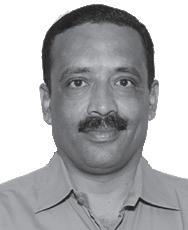
ISSUE 5 2023 ifj.com 13
Chase Machine and Engineering Designs and Builds Custom Converting Equipment Specifically for Your Application
or over 68 years Chase Machine and Engineering has been designing and building a variety of standard and custom converting machinery for WovenNonwoven fabrics, Films and Foils. From integrating independent modules to supplying Full-Scale Production Lines, we offer a comprehensive range of machinery that plays an essential role in the success of well-known brands and products worldwide.
As one of the premier design and manufacturing companies for custom web handling machinery, Chase serves a wide range of customers in the Textile, Medical, Nonwoven, Converting, Geotextile, Extrusion, Filtration, and Packaging Industries. We partner with leading manufacturers to produce applicationspecific equipment ranging from Festooners, Accumulators, Inspection Machines, Unwinds/Rewinds and Traverse Winders, to Ultrasonic Slitters, Laminators, and Cut-To-Length Machines.
Chase specializes in the integration of technologies such as Ultrasonics, Impulse Welding, RF Welding, Band Sealing, Hot Air Welding, Glue Dispensing, Hot Knives and Conventional Blade Slitters as well as Vision and Marking Systems.

Chase is a vertically integrated company, utilizing State-Of-The-Art 3D Solid Modeling Software for our machine designs. Within our 28,000 sq. foot facility, located in West Warwick RI, we program our PLC’s and HMI’s, build our Electrical Control Panels and Machine, Weld/Fabricate, Paint and Assembly our Equipment while maintaining tight control of quality and delivery.

We place a high priority on customer
and product confidentiality, and constantly seek to improve our quality and process controls as we help our customers improve their products and processes. Working together with our customers, Chase will deliver equipment that is Newer, Faster, more Efficient, and more Reliable for a timely return on your investment.
For those interested in product development, the Chase Materials Application Lab exists to help your team take their ideas to the next level. Whether creating new products or improving existing ones, Chase can determine the optimum method for manufacturing. Lab capabilities include web handling systems with ultrasonic technology for laminating, embossing, welding, slitting as well as
Visit our website www.chasemachine. com and see why Chase Machine and Engineering has adopted the tagline “EXPECT TO BE IMPRESSED.”
www.chasemachine.com
14 IFJ ISSUE 5 2023 ADVERTORIAL | SOLUTION CENTER: CONVERTING & WEB HANDLING
impulse welding machines.
F
Chase Specializes in the Integration of Technologies such as Ultrasonics, Impulse Welding, RF Welding, Band Sealing, Hot Air Welding and Glue Dispensing
Chase 144” Unwind/Accumulator/Autosplice.
Chase Ultrasonic Laminators.
Fi-Tech – Your Global Connection to the Top Equipment Suppliers for Synthetic Fiber and Nonwoven Fabric Production

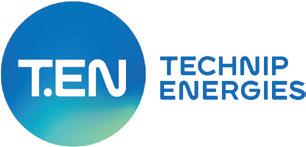

For more than 50 years, FiTech has connected the fiber, nonwoven and technical textile industries to the leading suppliers of production machinery and technical components. Since our founding in 1972, Fi-Tech consistently brings to the market the most advanced suppliers

with unique and technologically superior solutions giving our customers the competitive advantages they need to be successful today and well into the future.

From our home bases in Richmond, VA and San Luis Potosi, Mexico, the Fi-Tech Team is with you every step of the way from technical specification, to



order placement, to delivery and after startup spare parts support. The Fi-Tech Team is dedicated to providing the best products and customer service and to your success.
Fi-Tech is your Global Connection covering the USA, Canada, and Mexico. fi-tech.com

Our principals include:
by Spoolex
ISSUE 5 2023 ifj.com 15 ADVERTORIAL | SOLUTION CENTER: FIBER MACHINERY
Industry-Leading Case and Tray Packing Solutions
• Available in standard side-load, gantry top-load, robotic top-load configurations


• Compatible with RSC, HSC, and trays
• Large case range from e-commerce to club pack on one machine
• Product/case changeover in under 10 minutes
A
s a trusted partner to tissue manufacturers for over 60 years, Edson offers case and tray packing machinery for a wide range of applications. With low, medium, and high-speed solutions, Edson has helped over 90% of North American tissue mills pack and prepare their product for distribution. Features of these machines include flexibility, high speed, and easy integration into existing packaging lines.
Edson offers a variety of case and tray packing solutions for diverse industries, including:

• Converted paper
• Bathroom tissue
• Diaper
The case pack and tray packing systems
from Edson are designed to meet the growing demands of a variety of industries while adhering to budgetary, floor space, and speed requirements. Contact our team today! Edson.Sales@ProMachBuilt.com +1 905-385-3201


• Production rates up to 26 cases/min
• User-friendly HMI
• Ergonomic maintenance access
• Available with rear or side-infeed options
• Auto KDF loading (standard on 20+ case/minute, option on <20 case/ minute)
KDF Infeed Management System Packaging Solutions For:
• Removes bands, dunnage and data sheets
• Justifies and aligns stacks to datum
• Reduces labor reliance
• Eliminates downtime
• Increased safety
16 IFJ ISSUE 5 2023
ADVERTORIAL | SHOWFLOOR SHOWCASE: HYGIENE
Solutions for the Converting Industry. Made with SAHM Winding Technology.
We offer precision winders for a wide range of applications in the converting industry:

Security tapes and holograms
For banknotes, admission tickets, credit cards, etc.
Aluminium / PET compound foils
For data cables, automotive cables, etc.
PP adhesive tapes (tear tapes)
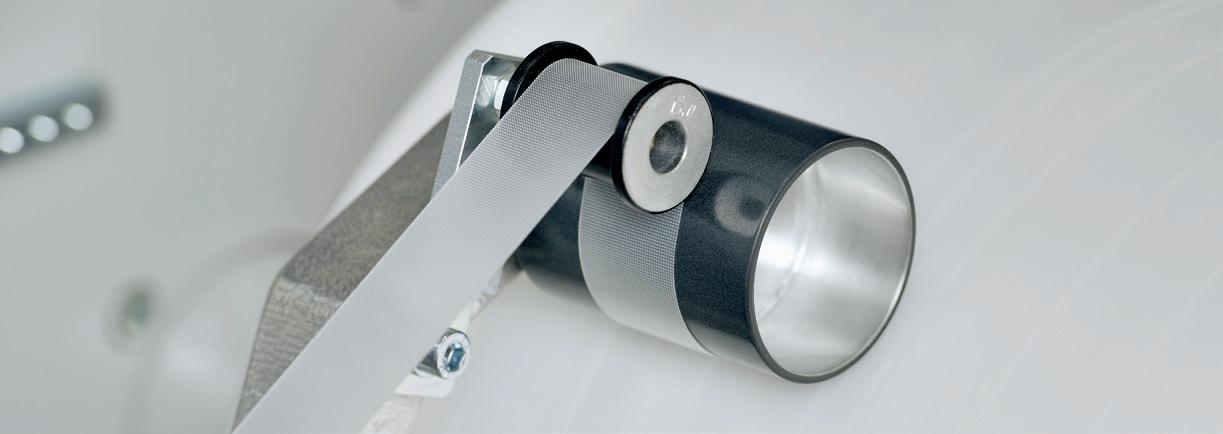
For cigarette packaging, food packaging, etc.
Miscellaneous applications
Nonwoven materials for diapers, rubber bands for tires, copper tapes for solar panels, etc.
“Made with SAHM Winding Technology” means we give customers our quality promise: All your materials will be wound with the highest possible precision for a positive impact on the quality of the final product.
Technology leader in winding solutions
Development & production in Germany
Service agencies worldwide
A MEMBER OF STARLINGER GROUP American Starlinger-Sahm, Inc. Fountain Inn, SC, USA www.starlingersahm.com office@starlingersahm.com Georg Sahm GmbH & Co. KG 37269 Eschwege Germany www.sahmwinder.com info@sahmwinder.com Jan 9 - 11, 2024, Booth 1335 Please visit us at
Innovation Super Stars Digital Color & Textile Recycling
 By Caryn Smith
By Caryn Smith

The best and brightest ideas from leading companies and new players in textile manufacturing and production were plentiful at ITMA Milan, which delivered on expectations. It is difficult to share all aspects that would do all justice. Rest assured, themes like reshoring, automation, production, traceability, circularity, and more, will be shared in future issues. Yet, two areas exhibited exponential innovation – playing a role in the emerging textile circular economy. They are digital textile printing and textile recycling. To understand the innovations, you must first review the issues they seek to solve.

Impacts and Solutions
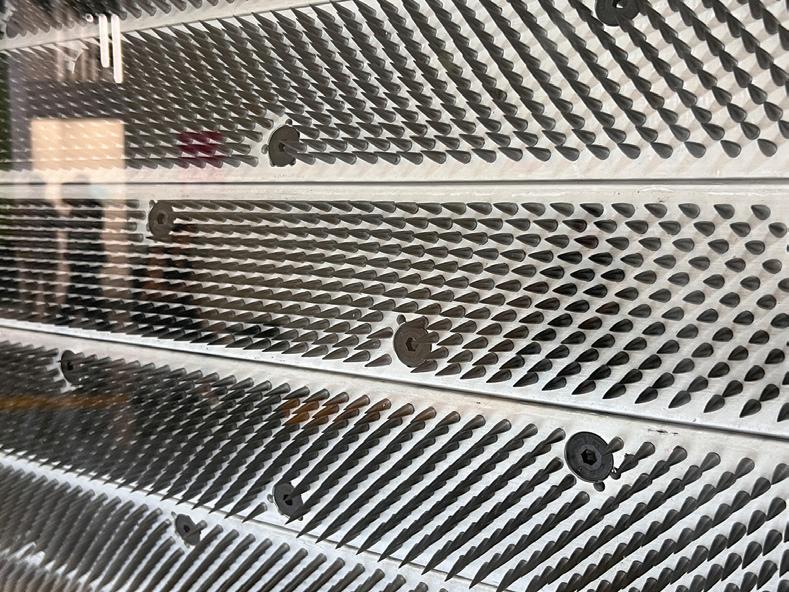
The textile industry’s exorbitant use of resources and generated waste are ever-present issues. As a reminder, according to the Geneva Environment Network (www. genevaenvironmentnetwork.org) in just fast fashion textiles alone, the statistics are grave. A search for sustainable fashion on their website is worth a look. Here are just a few facts that rising innovation can correct if adapted:
• The equivalent of one garbage truck full of clothes is burned or dumped in a landfill every second (UNEP, 2018)
• Approximately 60% of all materials used by the fashion industry are made from plastic (UNEP, 2019)
18 IFJ ISSUE 5 2023
SHOW REVIEW
Sustainable dyeing of textiles and textile recycling garners attention at ITMA Milan, with other innovations that increase textile sustainability, and offer textile producers on-demand options.
‘Transforming the World of Textiles’ was the theme of Mimaki’s ITMA 2023 booth, focused on sustainability, showcasing waterless digital textile print solutions through collaboration with fashion and textile designers. Insets: (L) Balkan Textile Machinery (pictured) and Trützschler partner to provide a complete line-up of technologically leading machinery which has been specifically developed for rotor and ring yarns from recycled materials; (C) ITMA attracted over 111,000 from 143 countries; (R) On display, Kyocera and Orange Fiber show off their collaboration to print on sustainable fabrics made utilizing citrus juice by-products with inkjet textile printer, FOREARTH.

• 500,000 tons of microfibers are released into the ocean each year from washing clothes — the equivalent of 50 billion plastic bottles (Ellen MacArthur Foundation, 2017)
• The fashion industry is responsible for 8-10% of humanity’s carbon emissions – more than all international flights and maritime shipping combined (UNEP, 2018). If the fashion sector continues on its current trajectory, that share of the carbon budget could jump to 26% by 2050 (Ellen MacArthur Foundation, 2017)
• Some 93 billion cubic meters of water – enough to meet the needs of five million people – is used by the fashion industry annually, contributing significantly to water scarcity in some regions (UNCTAD, 2020)
• Around 20% of industrial wastewater pollution worldwide originates from the fashion industry (WRI, 2017)
In the panel on Development of a Sustainable Digital Future, Kevin McCoy, Vice President, MADE, New Balance Athletics Inc., says, “You must look at the value. Doing the right thing is hard and can be expensive. Know that up front you’ll get attention as a challenger to the status quo. Regardless of technology, it starts with design. Design for manufacturing.”
These thoughts were echoed by others. During a press event discussion centered on Kornit Digital’s advancements (we will get to those shortly), Muriel Laurent, Director of Digital Marketing, at SOL’S believes that on demand and digital production are key to the future of textiles. “Print on demand is the most sustainable option for the future.” Jaymes Clements of Mad Engine says, “Retail brick and mortar have limited space. There is no need to premanufacture, when the product can only exists because someone has purchased it,” believing that this is a reliable business model for ensuring stability, efficiency, and growth in dynamic circumstances.
“Offering increased level of creativity, taking digital mainstream, brands need to change the way they think about production,” emphasizes Ronen Samuel, Chief Executive Officer at Kornit Digital. “With the ability to print on any kind of fabric, save resources, automated utilization systems, it is an evolution the industry has never seen before.”

Alon Moshe, Twine Solutions CEO, comments on the company’s newest technology, the TwineX4 digital yarn and thread dyeing system. “We believe this system represents the future of textile production and will be a huge change for our customers. We are confident that it will help textile manufacturers increase efficiency, reduce costs, and produce more sustainably.” The convenience of on-demand, in-house thread and yarn digital dyeing for small to medium-sized batches eliminates supply delays, supports the implementation of lower waste-to-landfill goals, reduces CO2 emissions in transportation, and has significant water and energy savings.
Switching topics to end-of-life textiles processing, the concept of recycling is catching on, but … Ever. So. Slowly. A McKinsey Sustainability report notes that less than 1% of textiles produced for clothing are recycled into new clothing, representing a missed revenue opportunity of more than $100 billion a year. With the popularity of synthetic blends, that task is complex, time consuming
and expensive. Yet, big brands like Levis, Adidas, and Zara have made recent news on their commitments to textile recycling.
New waste legislation in the U.S. could fast track recycling. A CNBC* news article recently reported, “In New York State, The Fashion Sustainability and Social Accountability Act, also known as the Fashion Act, would hold companies accountable for their recycling practices. It is currently backed by fashion brands like Eileen Fisher, Stella McCartney, Everlane, and Patagonia, as well as other advocacy organizations pushing to pass the bill.”
With those points made, let’s get back to solutions. ITMA Milan showcased many, and here are the ones that stood out with a splash of color.
* https://www.cnbc.com/2023/06/11/a-recycled-idea-at-levis-adidas-to-stopclothing-from-going-to-waste.html
ISSUE 5 2023 ifj.com 19
Kevin McCoy, Vice President, MADE, New Balance Athletics Inc. delivers an ITMA keynote. Ronen Samuel, Chief Executive Officer, Kornit Digital, with the new Atlas MAX POLY. Photos Caryn Smith
DIGITAL COLOR SOLUTIONS ON THE RISE
Kornit Digital
Kornit Digital LTD elevated their standard for sustainable, on-demand digital fashion and textile production technologies with its “Kornit ecosystem.” The company sees agility, versatility and green production as the future of fashion, sportswear and home décor as producers seek to minimize industry waste, without sacrificing quality or profitability. The tech allows for designers and retailers to focus on productivity, creativity, and on-demand flexibility.
At the center of this ecosystem is Kornit Apollo, offering high-throughput, on-demand garment decoration. It is a versatile automated solution for digital, single-step, short- to medium-run decoration of garments at high volumes, ideal for nearshore and onshore production models. Kornit customers can now achieve optimal total cost of ownership and the highest output per operator at up to 400 garments per hour for any type of job. Enabling digital production to go mainstream, Apollo allows customers to become more agile, drive revenue opportunities, shift to localized production, and ease complex workflow processes.

The main drivers offer quality digital on-demand printing to the mainstream for any fabric, while saving resources in production. The company’s bold impact statement reveals that by 2026, Kornit technology will enable production of approximately 2.5 billion apparel items in a responsible manner, saving 4.3 trillion litres of water, 17.2 billion kilograms of greenhouse gas emissions, and reduction overproduction in the fashion industry by 1.1 billion apparel items.
“Kornit Digital solutions directly answers surging industry demand for the highestquality, sustainable, on-demand manufacturing at scale,” says Ronen Samuel, Chief Executive Officer. “Delivering real industry change and bringing the market to the next level, the world’s biggest brands can now thrive in a market where anything is possible, and consumers can expect the world. Ultimately,” he says, “this enables brands or retailers endless design options, carrying no inventory until an order is placed.”
Kornit
The new Kornit Atlas MAX POLY makes short runs profitable with high-throughput and automated single-step processes, geared towards professional and recreational sportswear, teamwear, and licensed gear. This machine is the most efficient specialty system for polyester decoration, covering blends, tri-blends, and other synthetic fabric combinations. Colorful and vibrant prints using innovative neon inks are the star of this machine to produce retail-grade quality, durable goods.
The company has enhanced the Kornit Presto MAX capabilities, with industryfirst capabilities of brilliant white printing on colored fabrics. Kornit also unveiled NeoPigment™ Vivido ink set, which achieves darker, deeper blacks and colors to establish new fashion standards with a pigment-based process. Kornit’s patented solution is a streamlined and completely dry process for the most sustainable fabric decoration.
Epson
Versatility and sustainability were on display at Epson Como Printing Technologies, where the Monna Lisa line of textile printers were producing beautiful designs on textiles.

The company unveiled the new Monna Lisa ML-16000/HY, that can uniquely digitally create any type of special effect on fabric. The hybrid printer has been developed to reproduce the most sophisticated effects for modern printed fabrics with gold, silver, and glossy tints. “Our big news is the ML-16000/HY’s ability to expand beyond flat colors into metallics and special effects. It is really going to being something new and special to textile producers,” says Paolo Crespi, Commercial Director of Epson Como Printing Technologies (ECPT).

The combination of the ML-16000/HY’s 8 color inkset, 16 PrecisionCore printheads and 64 nozzles, enables the digital printing of special effects, previously exclusive to conventional screen or cylinder printing. The company’s Genesta waterbased inks (Acid, Reactive, Disperse and Pigment) guarantee color accuracy and resistance in fabric prints, while exclusive pastes developed and produced by ECPT create the special effects.
In sheer size alone, the ML-24000 delivers unprecedented flexibility and widest color range in the series. The highly flexible

20 IFJ ISSUE 5 2023
Kornit’s Apollo and Atlas MAX POLY, left, are cornerstones of the “Kornit ecosystem” of on-demand printers. Caryn Smith
Stunning samples from fashion designers were on display at Epson’s booth. Caryn Smith
Caryn Smith
solution is the first to be equipped with 24 Epson PrecisionCore printheads and 12 colors.

“All the line, from the mini-Monna Lisa to the new ML-24000 delivers the same quality, same process. They fit into any market experience,” says Crespi. “Studios can promote their own designs or collections, create prototypes, and more, with the flexibility of the Monna Lisa line which provide significant savings of time, energy and water.”
Furthermore, the integration of sustainability into the core business, with the ability to print on sustainable fabric –such as coconut or banana fibers – along with industry standard natural, artificial, and synthetic fabrics, contributes to the fashion’s transition towards a lower environmental impact.
“Special effect fashion market segment is on the rise,” notes Crespi as trends. “Home textiles collections will change style more frequently, not every five years. Big brands need to offer the stylists more possibilities to be creative. With production moved back to China, solutions like the Monna Lisa can provide a reshoring opportunity, marketed as sustainable in materials and as a viable business model. Lastly, it takes just one person to run our automated machines, or even several at a time, which offers better working conditions and helps with workforce management.”
NTX
NTX® Cooltrans® colorization is cool, for sure. The ink chemistry and technology is both a novel and waterless textile coloration solution. The breakthrough is the result of merging innovations in chemistry and machinery to deliver precise and accurate colorization of nearly any fabric material without heat, up to 90% reduction in water use, 40% reduction in dye use, while retaining uncompromising color fastness, hand feel, and functional performance. Three different systems, each with varying capabilities, make up the NTX® Cooltrans® family.
“We offer the best of digital sublimation, an extremely precise dosage process, offering color brilliance on all fabrics, polys, cottons, blends,” says Jeffrey F. Hsu, Chief Innovation and Marketing Officer. “Our machines offer double-sided printing, utilize shorter lead times, and produce amazing handfeel.” Also, he notes that NTX® Cooltrans® eliminates the tension and strain put on the materials and is therefore perfectly suitable to use with finer, lighter, and more delicate materials.


The newest offering, Eco-Denim, was the star of NTX show. To see the samples, you think you are looking at traditionally dyed denim material, but upon closer inspection, the printing tells a different story. Using panel or engineered printing technology, garments can be produced (i.e., printed) to replicate garment effects like simulated denim wear, distress, and an aged look with a precision that’s genuinely impressive. Moreover, it provides a quality answer to the fashion’s sustainability challenges with denim.
This new line of denim coloration not only looks and feels just like traditional denim, but it also brings with it substantial environmental benefits. By using panel printing, NTX® can create the classic worn and distressed effects on denim without resorting to water and energy-intensive methods to create them, thereby saving resources with shorter production cycles.
The time savings in production allows for time to apply a “final touch wash” to the denim. This process gives the jeans a truly authentic washed feel while still maintaining the impressive environmental benefits of NTX manufacturing process.

NTX is attracting brands such as Addias and Stella Blu to collaborate. “The really exciting thing is the cost-competitive aspect of implementing NTX® Cooltrans® into the value chain for our brand partners,” says Kalvin Chong, Chairman and Co-founder of NTX®. “The savings associated with lower energy requirements and water usage allow us to bring this game-changing innovation to ecology conscious consumers around the globe without impacting the manufacturing-costs of the final products.”

ISSUE 5 2023 ifj.com 21
Paolo Crespi, Commercial Director of Epson Como Printing Technologies (ECPT) Caryn Smith ML-24000 delivers unprecedented flexibility and widest color range in the series. Epson
NTX was busy with interest for Cooltrans® and Eco-Denim print technologies that deliver sustainable digital sublimation. Cooltrans® (left, top) offers great handfeel, double-sided printing and the use of various fabrics. Eco-Denim (left, bottom) provides the denim appeal through printing without the harmful processing fallout from traditional methods. Caryn Smith
DIGITAL COLOR SOLUTIONS ON THE RISE

Alchemie Technology
Alchemie Technology is on a water conservation mission with its own waterless smart dyeing machine, Endeavor.™ The company spent 10 years developing a digital print head for their machine, utilizing advanced digital manufacturing technology to deliver a breakthrough in the cost structure, supply chain capability and sustainability of fabric coloration.

The high throughput roll-to-roll single-pass technology delivers dramatic manufacturing cost reductions, profitability benefits, reduces minimum run lengths and enables rapid changeovers between colors and fabrics. The process delivers excellent handfeel, which has been assessed by major brands and designers to be equivalent to traditionally processed fabrics.
Dr. Alan Hudd, CEO & Founder, shared that the targeted tech solution is one answer to solve the industry’s water pollution problem. It is the second largest contributor, at over 20%, to global water pollution. “Demand in 2030 will increase 40% for fresh water. We are on a journey to a no-green-premium,” he notes. “Further, there are 1.2 billion digitally defined drops per linear meter of fabric. This precision means no excess dye is used.”
The Endeavour™ reduces the carbon footprint of dyeing by over 85%. This is significant because textile dyeing and finishing is responsible for approximately 3% of global CO2 emissions (Quantis Report 2019). The company claims to have significant cost reduc-

Kyocera
tions of energy consumption greater than 50%, reduction of energy consumption by greater than 85%, with digital manufacturing agility to address the 25% materials waste in the supply chain.
Unlike other digital printing systems, the Endeavour™ process is designed to be compatible with all colorant chemistries used in traditional dyeing. The system is an open platform, and any approved commercial colorant chemistry can be used in the system. The system can also be used with reactive, acid dyes, Vat dyes and a range of specialty colorants to enable digital dyeing with a wide range of substrate types. The production line replaces between three and ten traditional jet dyeing machines and the footprint and labor requirements are significantly reduced versus the traditional dyehouse.


Works of art served as décor and samples of the brilliant reproduction of the Kyocera FOREARTH® digital textile printer. From largesize motifs, photos, random motif patterns to gradation, the print possibilities are endless, and especially suited for women’s fashion, sports and kids’ wear and home textiles. The system utilizes Kyocera Integrated Printing System (KIPS) to realize high-quality printing on a wide range of fabrics, including cotton, silk, polyester, nylon and blended fabrics. This offers FOREARTH® an edge for textile producers who what complex designs to print with a luxury handfeel.

As a two-step process, printing and drying, no water used in production like other systems. The difference lies in the Allin-One Textile Printing System – KIPS, whereby FOREARTH® installs Kyocera’s inkjet print head which is top global share* for its digital textile printing, and by incorporating KIPS proprietary Picfy® pigment ink, pre-treatment liquid, and finishing agent, where the water free concept is realized.

It has 18 printheads (Color – 16; Pretreatment Liquid – 1; Finishing Agent – 1), utilizing up to 8 colors (CMYK + 4 special colors) with a maximum print width of 1800MM and maximum cloth width of 1850 mm. Resolution is a sharp 600x600 DPI and print speed comes in at Standard: High-quality mode; 2 pass, 250 m2/h. The capacity and color is a show stopper.
*In terms of printing area, according to 2022WTiN.
22 IFJ ISSUE 5 2023
NOTE: “FOREARTH” and “Picfy” are trademarks or registered trademarks of Kyocera Corporation in Japan and other countries.
Kyocera’s FOREARTH has a patented circulating inkjet head and original pigment ink that enable printing on a wide range of fabrics. Caryn Smith
Dr. Alan Hudd, CEO & Founder of Alchemie Technology, shares key benefits of their waterless smart dyeing machine, Endeavour™ (left, top). It utilizes advanced digital technology precision colour matching and shade control (left, bottom), as an open platform system for use with any commercial colorant chemistry. Caryn Smith
Alchemie
Kyocera
Twine Solutions
Colorizing thread and yarn are also experiencing disruption. Twine Solutions brings innovation, the entrepreneurial spirit and decades of experience in the print and software industries to its new solution.


TwineX4 is a next-generation waterless, digital dyeing system for thread and yarn dyeing production, where textile manufacturers can optimize production processes, with accuracy, speed, efficiency and, yes, sustainability.
The system offers convenient on-demand, in-house capabilities for small to medium-sized batches, eliminating supply delays. This provides the quality product designers and textile producers want, with the flexibility to accelerate order fulfillment, and increase capacity to match the fast-paced demands of the fashion industry.
Sharon Ezra, Twine’s Product and Application Expert, and a fashion designer in highend Italian brands, says, “I know firsthand how big of an issue is color choice when it comes to samples and production processes. Brands always seek to differentiate themselves and want to know what colors you have in stock. Many times, you must compromise when the color you want is not available. With on-demand, you can print as many colors as you want.”
Highly energy-efficient, this system’s consumption is approximately 2.7 times more efficient per kg compared to the traditional dyeing processes. In-house dyeing allows designers to produce
RECYCLING SHIFT: SUSTAINABLE APPROACH AT END OF LIFE
Erema Group
PureLoop, member of Erema Group, shared their latest development in plastics recycling – the ISEC evo FibrePro:IV, specially designed for processing PET continuous fibers and fabrics. PureLoop specializes in combined shredder-extruder technology for the highly efficient recycling of clean production waste.

“Our ISEC evo machine is a material all-rounder for inhouse recycling that is particularly adept at processing fibers and textiles and has already been used for this application many times over. PE, PP, PA and PET in the form of fiber bales, ropes, filaments, textiles and nonwovens can be recycled using this shredderextruder combination,” says Manfred Dobersberger, Managing Director, listing some of the system’s special capabilities.
PureLoop displayed an innovative pilot project in fiber-tofiber recycling of polyester, a sample t-shirt which was made from 30% PT fiber recycled regranulated content from the ISEC evo FibrePro:IV. The project was in cooperation with RadiciGroup, a renowned Italian-based international fiber manufacturer. “Re-
exact lengths of thread and yarn, reducing wasted materials by up to eight times the amount resulting from external supplier MOQs, and supporting lower waste-to-landfill goals. It also helps to minimize electricity and carbon emissions by reducing the need for excess inventory storage and streamlining the supply chain.
TwineX4 meets production requirements with its exceptional dyeing speed, averaging 21.6 kilometers per hour, wound on four cones, each capable of accommodating up to 1.5 kilograms in a single run. With its upgraded capacity, TwineX4 can dye up to two tons of thread/yarn per year.
cycling has enormous potential in the fiber and textiles sector. One thing I am sure of is that recycling will become a standard feature within the industry in the future. This project, initiated by the Radici Group, sees us taking an important step towards more sustainable production of fibers and textiles,” says Merlijn van Essen, Sales Manager, and responsible for this cooperation. (Continues on page 24.)
ISSUE 5 2023 ifj.com 23
FibrePro:IV Erema
TwineX4 is a waterless digital system for thread and yarn dyeing production for on-demand in-house capabilities for small- and medium-sized batches. Caryn Smith
RECYCLING SHIFT: SUSTAINABLE APPROACH AT END OF LIFE
PureLoop, and its ISEC evo FibrePro:IV, and RadiciGroup, an Italian-based international fiber manufacturer, collaborated on a pilot project in fiber-to-fiber recycling of polyester to manufacture a t-shirt made from 30% PT fiber recycled content, regranulated from the PureLoop system.



Trützschler
From waste to value is the mantra of TRUECYCLED recycling installations from Trützschler, makers of spinning technology solutions, as well as options for nonwovens, card clothing and man-made fibers.

In a partnership with Balkan Textile Machinery, Inc. Co , Trützschler closes the loop and supports a circular economy by becoming the first full-liner in spinning preparation for recycling. Both Balkan and Trützschler are family-owned companies for whom sustainability in the textile chain is a major concern. Balkan’s machines help to cut, mix and tear textile waste into fiber tufts that are then pressed into bales of secondary fibers, which can be fed into the preparation process with Trützschler machines. Customers benefit from combined, perfectly finetuned, reliable and reproducible processes.
Once shredded, Trützschler blowroom lines for recycling feature flexible setting options and intelligent processes, facilitating perfect opening, cleaning and blending of synthetic and cotton secondary fibers. They also prevent unnecessary waste or new short fibers from being produced. The intelligent Card TC 19T for recycling converts shredded textile waste into quality fiber slivers for new yarns, the TRUECYCLED® brand.
(Continued from page 23.)
“This system offers fiber producers the ability to use recycled pellets in production, made from industrial waste,” says Gerold Breuer, Head of Marketing & Corporate Development, Managing Director. “The production from waste is in their hands, to use in the best possible way. They are in control with the ability to produce different through-put sizes.”
In August, the Erema Group launched another collaboration with Lindner Holding, in a 50:50 joint effort to create BLUEONE Solutions, a holding company focused on sharing expertise to execute research to create industry standards in plastics recycling. Lindner Washtech’s experience as a quality manufacturer of shredders and recycling facilities for the waste management industry for the 75 years will be combined with that of the extruder manufacturer Erema, active in plastics recycling for 40 years.
“‘A functioning recycling industry demands a focus on the entire process and value chain from waste collection and processing to recycling and the final plastic product,” says Manfred Hackl, CEO, Erema Group. “In detail, the recycling extruder, the upstream washing system and material handling can be optimally coordinated so that quality standards can be ideally met, and energy optimized – thanks to cross-process control and monitoring, supported by digital solutions. In the future, we will offer optimally coordinated all-in-one solutions that will enable our clients to buy a total package that is perfectly tailored to their needs.”
“We are now able to provide a complete line-up of technologically leading machinery which has been specifically developed for rotor and ring yarns from recycled materials,” says Markus Wurster, Director Sales and Marketing at Trützschler Group. “Customers benefit from less complexity when planning and executing a mill project. The combined processes from Trützschler and Balkan are perfectly fine-tuned, reliable and reproducible. And of course, customers have access to Trützschler’s premium service.” Osman Balkan, Owner of Balkan Textile Machinery, Inc. Co., adds: “I am very happy that we can join forces with such a strong international player like Trützschler. Together we can make a significant contribution to dealing with textile waste globally.”
24 IFJ ISSUE 5 2023
Caryn Smith
Balkan and Trützschler partnership was evident in the TRUECYCLED® display of machines and results. Caryn Smith
Starlinger
Starlinger brings its recycling system to the industry with its recoSTAR line of equipment, which includes systems for non-wovens, woven bags, film and post-consumer waste. The technology offers a spectrum of innovative machinery solutions for the efficient recycling of a variety of plastics, such as PE and PP, PA, PS, PLA, PMMA, and many more. For PET bottle-to-bottle recycling applications, Starlinger offers the new recoSTAR PET art, an energy-efficient and user-friendly recycling system. It achieves 15% more output with less maintenance and space requirements than the previous model and saves around 21% in production costs.

Andritz
The display at ANDRITZ was all about recycling, in which the company has invested heavily. They have mechanical, chemical combined solutions, or anything a customer would want. ANDRITZ Recycling offers single equipment and complete conditioning systems comprising the following process steps: material feeding, shredding, conveying, separation, fine grinding, and storage of the finally conditioned material.
Textile fiber preparation lays the foundation for the subsequent textile recycling process steps, and ANDRITZ offers single equipment and complete fiber preparation systems, from material feed and shredding or tearing right up to the finally prepared textile material.



recoSTAR universal allows processing of fibres, filaments and nonwovens without precutting; only pre-portioning to fit conveyor belt dimensions is required. Starlinger
In other efforts, “As part of our ‘Circular Packaging’ concept, big bags made of polypropylene fabric are equipped with a material passport that allows to trace their life cycle from production to use to return and recycling,” explains Harald Neumüller, CSO. “This means that used big bags can be recycled without significant loss of quality and the regranulate used for producing new big bags – the packaging cycle is closed.”
Each recoSTAR line has specific characteristics, but the main features are common to all. Design is modular, so that based on the input material a line is configured from individual modules which are adaptable if necessary. As input materials and reapplication possibilities change, modules can be added and adaptations made in response to the market. Easy accessibility for maintenance, touch screen and visualization, one-button start-stop, inline quality control tools, and other features help reduce operating costs. So does the energy-efficient design – another mark of uncompromising commitment to sustainability.
Designed for recycling plastic scrap from industrial and postconsumer applications, recoSTAR dynamic are especially suited for processing hygroscopic, wet and/or pre-ground and foamed materials. recoSTAR universal allows processing of fibers, filaments and nonwovens in the ACTIVE shredder without pre-cutting; only preportioning to fit conveyor belt dimensions is required.
Recycling contributes significantly towards a positive perception of PET packaging: It increases ecological awareness and induces collection of post-consumer waste and obligatory reuse of recycled PET (rPET). Major brand-owners jump on the bandwagon and promote low carbon footprint and resource conservation.
“In the area of textile recycling, we are at the heart of the movement for state-of-the-art recycling solutions and collaborate with internationally renowned partners,” says Dr. Joachim Schönbeck, Chief Executive Officer. Earlier this year, the company delivered, installed, and commissioned a mechanical textile recycling line and an airlay line at Novafiber’s nonwovens production mill in Palín, Guatemala. The recycling line – the second tearing line they’ve supplied to Novafiber – processes post-industrial textile waste from Central America.
Overall, ANDRITZ has a diversity of solutions and cooperating partners covering the value chain from recovery of fiber to production of new yarn.
ANDRITZ offers a wide range of tearing machines to recycle textile waste into fibers from small to high volumes for respinning to new yarn, or to produce nonwoven roll goods and panels. Caryn Smith

ISSUE 5 2023 ifj.com 25
DEFINING COTTON RECYCLING at the Next Level
By Adrian Wilson, IFJ International Correspondent
Since 2019, Säntis Textiles has been producing around 300-350 tons of 100% recycled cotton monthly using specially-developed RCO100 technology at the plant of its partner Kipas in Kahramanmaras, Turkey.
The technology has been under development since 2016 and was commercially launched for third-party manufacturers by a second Kahramanmaras-based company, textile machinery builder Temsan, at ITMA 2023 in Milan in June.
“Our main business is still technical and home textiles, but since 2010 we have worked on recycling, initially with polyester and from 2016 with cotton,” explained Stefan Hutter, owner of Säntis Textiles, which is headquartered in Singapore and now has a branch office in Switzerland. “Recycling will be a significant pillar for us going forward and for me it’s like the closing of a circle.
“The challenge of developing the technology for 100% cotton recycled yarns and fabrics took us initially to China where we did trials with different machine modules and moved them around until we obtained some first encouraging results. It took us about two years until we were able to produce denim fabrics and some chinos and knits out of 100% recycled cotton.”
Kipas
Säntis then moved the project to Kipas where the first full RCO100 recycling system was installed.
Kipas Holding is a conglomerate of 25 companies with more than 10,000 employees and annual sales of more than $100 million. Its textile operations have
Annabelle Hutter with textiles ready for recycling. Globally, just 15% of post-consumer textile waste is recycled with the remaining 85% often ending up in a landfill. The ambition of Säntis Textiles, alongside their partners from the textile industry, is to take steps to reverse these numbers as they believe that the recycling and upcycling manufacturing model is the only way forward, not just for our industry but for the planet as a whole. Their 100% recycled cotton is the first of its kind in the market. This recycled cotton fabric is made from pre- and post-consumer cotton, textile waste and leftovers from fabric production. They spin this waste, collected from over 100 sources in three countries, into strong staple fibers with impeccable quality. Not only is this officially verified, but also when woven together, they create the highest quality of sturdiness and durability, perfect for daily use. Santis

26 IFJ ISSUE 5 2023
SUSTAINABILITY
an annual capacity of 400,000 tons of yarn and 100 million meters of woven fabrics, with an emphasis on denim.
“Kipas is fully vertical, with spinning, weaving, dyeing and finishing under one roof and is also a major denim producer,” Hutter explained. “Kipas then introduced us to Temsan which is in the same region and this made development of the project very fast. If something was needed or had to be changed on the machine, the guys from Kipas would go over to Temsan immediately to look at issues, fix them and learn. It seems incredible that 15 months after receiving the first technical drawing, they had produced a commercial machine. The Temsan team worked day and night to have the machine ready for ITMA.”
“Sustainability has become a critical factor in the textile industry,” added Cem Erdoğrul, managing director at Temsan. “There is a growing need for recycling, both pre and post-consumer, to reduce waste and promote a circular economy. While this project may be an initial step, it shows that we recognize the importance of embracing recycling technologies to create high quality, sustainable textiles.”
Fiber Length
The RC100 recycling system has been developed to carry out the gentlest fiber treatment in order to achieve maximum fiber length.
A standard line includes two conveyors and two guillotine knives positioned at 90-degree angles to achieve the best possible cutting results.

An initial buffer unit also acts as a mixing chamber for the cut material and controls the feeding to the four pin or saw-toothed pre-opener cylinders.
Feeding of the cylinders is through feed rollers but without clamping points or counter-rotating cylinders. Transport is by perforated drums which not only dedust the fiber sliver, but also forward it without stressing the material.
From the pre-openers, the material is sent to three parallel fine-opener lines, each equipped with 12 opening cylinder modules. It can be run through the
system as many times as necessary until the fibers are fully opened before being pressed into standard bales.
Compact Spinning
In addition, working with Swinsol, a Swiss machine components specialist, Säntis has developed a compact ring spinning system specifically designed for yarns to be produced from the RCO100 recycled fibers.

“From day one our aim was on retaining fiber length – the only way to achieve good results in spinning and weaving,” Hutter said. “Turkish cotton has a staple length of approximately 31-32mm and when we recycle this we achieve an 80% staple length of approximately 25-26mm. The output length depends on the input length of course, but we can say we have approximately 15-20% loss. We can also retain longer fibers by reducing the production rate.”
The RC100 technology can spin Open
End yarns in counts from Ne 5.9-20 and carded ring compact yarns from Ne8-30. In addition, carded ring compact yarns can be produced up to Ne20 with 40 den and 70 den recycled elastane.
“All of the other players on the recycling market come from the nonwovens sector because it’s all about tons per hour, but a lot less about fiber quality,” Hutter said.
Brand Support
Säntis has ongoing partnerships with fashion brands such as Tommy Hilfiger, Calvin Klein Jeans and Lacoste, and is also partnering with FibreTrace to develop a unique traceable ID specifically for RCO100 fibers, yarns and fabrics.
FibreTrace technology gives brands 20/20 vision of their supply chains at every step from sourcing of raw fiber to store, combining physical and digital technology to provide unparalleled intelligence. It is indestructible through the entire textile supply chain, auditable and traceable in real-time, verifies brand claims, builds trust and engages the consumer.
Since 2020, Hutter has worked with his daughter Annabelle Hunter, who is now Säntis’ managing director.
“We had a fantastic time at ITMA this year,” she said. “The textile world is changing – there is legislation coming, first in the EU, and this will give the recycling sector a big push.”
ISSUE 5 2023 ifj.com 27
Stefan Hutter, owner of Säntis Textiles (right), shares the RCO100 line with ITMA attendees. Caryn Smith
Illustration of the Säntis RCO100 line configuration displayed at ITMA 2023. Adrian Wilson
“We now have further ideas in development for combining our recycling system with spinning technology and also on approaching the recycling of poly-cotton blend fibers,” said her father.

All in the Family …
“We are a family-owned company built on generations of Swiss textile expertise,” Annabelle Hutter proudly shares as the next generation leader in the company.
Her grandfather was a textile engineer at Saurer, where Stefen Hutter also did his apprenticeship before moving to Rieter, where he worked for many years.
Säntis was formed in 2016 and Annabelle joined the company four years ago, when they were at the stage of commercializing the 100% recycled cotton.


“I’m really proud of the invention of our RC100 technology because this machine is not exclusively designed to downcycle
– it is designed to recycle, and that means textile-to-textile directly,” she says. “That was the whole notion from the beginning. The machine’s gentle opening system shreds very gently.”
On being in the family business, she says, “Working with my father has been a very exciting journey. It hasn’t always been easy, but it’s very rewarding and I think it’s a great synergy we have. I am more of the creative thinker and he’s definitely the technical brain in the family. I really believe that more daughters should hopefully strive to work with their fathers one day.”
Stefan shares he is confident in what Annabelle brings to the company will expand its vision. “I’m very happy to have had Annabelle on board since 2020. She is in charge of the newly-established Säntis Textiles in Switzerland, which focuses mainly on the marketing and promotion of our recycled cotton technology. For me, it’s nice to have a family member to continue what we began. It’s also nice to see how fast she has learnt about the textile process and how she’s willing to elaborate on her own ideas. Annabelle’s also an inspiration for young women to work in this industry and I couldn’t be prouder.”
Adrian Wilson is an international correspondent for International Fiber Journal. He is a leading journalist covering fiber, filtration, nonwovens and technical textiles. He can be reached at adawilson@gmail.com.

28 IFJ ISSUE 5 2023
Turkey’s Temsan launched the RCO100 system in Milan. Adrian Wilson
“I’m really proud of the invention of our RC100 technology because this machine is not exclusively designed to downcycle – it is designed to recycle, and that means textile-to-textile directly.” — Annabelle Hutter
The Hutter Family. Caryn Smith

From Industry 4.0 to Research 4.0
A Modular Approach for the Development of Continuous Filaments Based on Man-Made Cellulosic Fibers
By Steffen Müller-Probandt and José Canga Rodríguez
An accelerated growing demand for textile fibers demands a more proactive approach which includes implementing frameworks and technologies for recycling and a broad use of biobased materials as an alternative to conventional polymers. Research work in the field of biobased fibers is characterized by a high degree of adaptation needs, hence demanding an efficient, systematic and, in part, self-optimizing experimental working system, which must be intelligent in gathering data from the process and flexible in enabling its rearrangement. Research 4.0 is a modular approach for the development of a product from the idea to its practical implementation.
Meeting Industry Demands
The global demand of textile fibers has been almost doubled from approximately 60 to 110 million tonnes per year from 2000 to 2020 while the number of produced garments increased three times from approximately 50 billion to 150 billion. With cotton stagnating at 20 to 25 million tonnes, the main contribution to this growth is provided by man-made fibers like polyester. In the same period, the world’s population has increased by approximately 30% to reach almost 7.8 billion people.[1] The mismatch between both growth rates reflects an imbalance
leading to the unsustainable situation which we are currently facing.
In 2015 only 1% of textile products were recycled at a global level as the result of the big challenges that the textile industry is facing in order to reach circularity.[2] The factors are manifold: undesired substances which are embedded in the yarns and cannot be recycled, the fact that many garments are made of mixed materials which are hard to separate, recycling costs being higher than the value of virgin materials, etc.

Technical textiles refer to textile materials primarily used for their technical performance and functional properties. They make roughly 35% of the total production of fibers worldwide.[3] The global
yearly consumption of technical textiles was approximately 42 million tonnes in 2021 and is expected to reach no less than 67 million tonnes by 2032, thus experiencing an increase of roughly 60%. In monetary terms the technical textile market is estimated to reach 43% of global textile sales by 2032 [4], so that the size of this market size is projected to grow from $164.6 billion in 2020 to $222.4 billion by 2025, i.e., at a CAGR1 of 6.2% [5] .
Given the anticipated rapid increase in demand for textile fibers in the years to come, it is crucial to implement transformative sustainable consumption and production models and circular business technologies both in the garment and technical textile industries.
30 IFJ ISSUE 5 2023
INTELLIGENT MANUFACTURING
Figure 1. Mass flow of textiles from raw material to disposal. Ellen MacArthur Foundation
Recycling Technologies
The Ellen MacArthur Foundation defines recycling as the last value cycle after other measures (inner value cycles) to restore and regenerate value with the lowest environmental impact possible [2]:
a) Maintain/repair
b) Reuse as a product
c) Reuse as a material
d) Recycle
Users represent the keystone for closed loops based on their behavior towards usage, maintenance and repair of textile products expanding their lives to the maximum possible.
Technical textiles are commonly not feasible for reuse as they usually reach their end-of-life status based on damage rather than based on fashion as is the case for garments. Reuse of textiles can be done as products (preferred option) or as textile material. When the quality of the fabric is such that it is no longer suitable for reuse as a product or material, it should be recycled.
There are mainly four main recycling technologies defining the industrial processing of new fabrics [6]:
a) Mechanical recycling resulting in fibers as the raw textile material is broken down in separate fibers which can be re-produced into new textile structures.
b) Chemical recycling of cellulosebased textile products (e.g., cotton, viscose, etc.) which are dissolved and spun into new fibers.
c) Thermo-mechanical recycling of synthetic polymers, where polymers are melted and chemically improved (if required) before being spun again.

d) Chemical recycling of synthetic polymers that are broken down to their monomers. Monomers can be polymerized again into the original polymers.
According to the EU Strategy for Sustainable and Circular Textiles, longlived and recyclable textile products will be placed in European markets. These products will be made of recycled fibers to a great extent and free of hazardous components. The vision of the European
Commission is a thriving ecosystem for circular textiles supported by sufficient capacities for fiber-to-fiber recycling and feasible services for reuse and repair. [7]
Biobased Fibers for Recycled and Sustainable Textiles
As consumers are nowadays searching for more sustainable solutions that address key environmental issues related to the garments they wear, there is a growing trend towards sustainability in the textile industry at a global level. This new situation is building up pressure on textile brands by holding them accountable for their environmental impact in a way that consumers expect meaningful social and environmental goals (e.g., ambitious CSR2 and ESG3 KPI’s4) and a trustworthy implementation of a sustainable product stewardship. This paradigm shift involves both the implementation of recycling approaches and a broad use of biobased materials like MMCFs5 as an alternative to polymers like polyester and nylon. MMCFs, also known as regenerated cel-
lulose fibers, are a group of fibers that are conventionally derived from wood, whereas other sources of cellulose are gaining importance nowadays (e.g., alternative plant resources, recycled agricultural waste, etc.).
A value-added hierarchical usage of biomass is a keystone in building a more environmentally friendly textile production. In the cascade utilization of resources proposed by the European Directive 2008/98/EC [8], cellulose-based fibers would be one of the many different products to be processed out of wood in future bioproducts mills. In order to make out of biobased fibers a real competitor to established polymers like polyester or nylon, both securing feedstocks and a further development of spinning technologies will be essential.
Multimode®:
A Research 4.0 Solution for Biobased Fiber Innovation
Research 4.0 is to be understood as the implementation of the principles of Indus-
ISSUE 5 2023 ifj.com 31
Figure 2. Value cycles and recycling paths for textile products. Ellen MacArthur Foundation/VTT Technical Research Centre of Finland Ltd.
Given the anticipated rapid increase in demand for textile fibers in the years to come, it is crucial to implement transformative sustainable consumption and production models and circular business technologies both in the garment and technical textile industries.
Starting from thread run studies on coating facilities to complete pilot installations can be implemented efficiently also to your task with the DIENES MultiMode® system. DIENES
try 4.0 to research facilities. VDMA6 has developed a toolbox in which the stages of development represent the path to the realization of an Industry 4.0 solution. [9]
Cellulosic fiber products pose a big technological challenge as growing demands on the varying quality of biobased (virgin or recycled) feedstock and the achievement of a consistent fiber performance require a continuous development and optimization of both technology and production parameters.
Therefore, the technology required for the development of biobased fibers for sustainable garments and technical textiles should be intelligent and able of organizing itself. The spinning line will be divided in modules, which become cyberphysical systems that network with each other. Ahrens tries to get to the bottom of this terminology and delimits the artificial intelligence of technology from the human-centered concept of intelligence. He puts it: “Against such a background, it does not matter if technology is artificially intelligent or not, but on the fact that it supports people in bringing their intelligence and autonomy to full effect.” [10]
Hence, the focus shall be on the needs of researchers developing new biobased fiber materials. The Research 4.0 solution will be supporting the research team under a human-centered approach to create a system that can operate autonomously and with the capacity of organizing itself. Either the starting point is technology which shall be equipped with social skills and characteristics such as in intelligence, autonomy and self-organization, or the human being
is the starting point and the technology the one to be reshaped to better support people in bringing their capabilities and qualities to full effect. [10]
Research work in the field of cellulosic fibers is characterized by a high degree of adaptation needs. Research facilities must be able to be adapted after initial experiments and the knowledge gained thereby. The necessary adjustments are made under the conditions of a highly complex manufacturing process, which is determined by many influencing parameters. This results in the following requirements for the flexibility of the electronics control of the research facilities:
a) Integration: Easy integration of new production modules.
b) Scalability: Easy replacement of production modules with modified specifications.
c) Flexibility: Easy modification of production steps’ positioning within the production line.

d) High Performance: Intelligent production modules synchronized by a master process control level.

e) Analytics: Continuous monitoring and evaluation of process parameters.
A reliable development of textile and technical filament yarns demands an efficient, systematic and, in part, self-optimizing experimental working system, which must be intelligent in gathering data from the process and flexible in en-
32 IFJ ISSUE 5 2023
Figure 3. MultiMode® – Hierarchical structure. DIENES
abling the rearrangement of the process. DIENES’s approach to meet such demands is called MultiMode®.
In a MultiMode® plant, each process step is represented by a module which can be individually adapted to customerspecific requirements and has its own decentralized control. Thus, a modular production line consists of several intelligent units which can be easily exchanged and rearranged at any time with a reduced programming effort. Moreover, all production parameters can be permanently visualized and recorded, enabling a complete traceability of the process.
DIENES supports its customers in the development of innovative sustainable products like precursor yarns for carbon fibers made from biobased raw materials offering a modular approach for the development of a new product from the idea to its practical implementation covering all stages of the complete validation process from the first lab trials up to an industrial scale production line: Principle Process Product Production.
The configuration of a MultiMode® system follows a hierarchical structure running at three levels: Slave (Level 1MMS: MultiMode® Slave), Master (Level 2 - MMM: MultiMode® Master) and Upper control (Level 3 - MME: MultiMode® Explorer).
Every single yarn treatment module represents a production step and can store knowledge at module level and act according to the function of the module in interaction with other modules. Each of these modules is equipped with a MultiMode® switch and control cabinet, hence it is equipped with its own intelligence based on a PLC to control itself and to organize the module in association with other modules in the plant. The control hierarchy has an intelligent modular structure that configures itself according to the arrangement of modules given by the hardware and the interfaces within the system. Thus, a structure is realized that allows new arrangements by configuration and without any programming work required.
From a control perspective, the process level with the MultiMode® boxes
forms the control level “BASIC” with the MMS modules. Up to 14 of these basic modules can be switched to one MMM. This second control level “INTEGRATED” is organized by the MMM, which is also responsible for configuring and forwarding the information to the computerbased MME.
High requirements for a flexible control system and expectations regarding ergonomics are met at this level of integration:
a) Easy extension or reorganization of the modules in the line.
b) Different configurations of modules can be tested in a short period of time.
c) Individual modules can be operated as standalone machines outside the line. The computer level control (MME) can be connected with four MMMs, that gives the possibility of 56 MMS modules connected to their corresponding MMM
Steffen Müller-Probandt, born in Frankfurt am Main in Germany studied Machine Construction and Economics graduated as Dipl.-Wirtsch.-Ing. TH-Darmstadt. Experienced manager in leading positions in Sales, Marketing and in Research and Development followed by top management positions for several well-known companies in the sector of textile machines. Since 2003 owner and CEO of Dienes Apparatebau GmbH. Under his leadership the company has evolved into a leading manufacturer of modular laboratory, pilot, and production lines for high performance filament yarns. He can be reached at muellerprobandt@dienes.net.
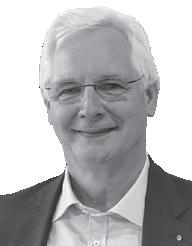
References
with their own local input displays or to an industrial PC via gateways allowing all visualization and control options by means of a touch screen as acting as HMI.
The upper control level is the process control level “ADVANCED” and organizes the elegance functions of the system like, e.g., real-time evaluation of sensors, data logging with a connection to an SQL database every second, tracking of operator inputs, transfer of data to Excel for further evaluation, alarm logging, recipe management for saving current settings as a recipe under a freely assignable name to be used a later moment if necessary, etc.
1 Compound Annual Growth Rate
2 Corporate Social Responsibility
3 Environmental Social Governance
4 Key Performance Indicators
5 Man-Made Cellulosic Fibres
6 Verband Deutscher Maschinen- und Anlagenbau (German Machinery and Equipment Manufacturers Association)
José Canga Rodríguez, born in Oviedo (Spain) in 1976, studied Chemical Engineering and is MSc in Environmentally Sustainable Process Technology. Over the last 17 years he has been working in different R&D, Engineering and Sales positions at companies delivering turn-key plants for paper making and recycling, industrial wastewater treatment and disposal of hazardous weaponised chemicals and ammunition. Since 2020 he is working as Head of Sales at Dienes Apparatebau GmbH providing modular spinning lines for innovative and sustainable filament yarns at lab, pilot, and production scale. He can be reached at j.canga@dienes.net.

1. Cordeiro et al.; Becoming mainstream: Future opportunities and challenges for novel textile; International Conference on Cellulose Fibres, Cologne, 2022
2. Ellen MacArthur Foundation; A new textiles economy: Redesigning fashion’s future, 2017
3. Market demand of technical textiles worldwide in 2014 and 2022 (in million tons). In Statista – The Statistics Portal, available at https://www.statista.com/statistics/741532/technical-textiles-global-market-demand/ (accessed on March 13th 2023)
4. Fact.MR (February 2022). Technical Textile Market.https://www.factmr.com/report/technical-textile-market (accessed on March 3rd 2023)
5. Markets and Markets (2021). Market Research Report (February 2021). https://www.marketsandmarkets.com/PressReleases/technical-textile.asp (accessed on March 3rd 2023).
6. Fontell, P., Heikkilä, P.; Model of circular business ecosystem for textiles, VTT Technical Research Centre of Finland Ltd, November 2017
7. European Union Strategy for Sustainable and Circular Texiles. European Commision, February 23rd 2022, https://eur-lex.europa.eu/ legal-content/EN/TXT/?uri=CELEX%3A52022DC0141 (accesed April 14th 2023)
8. European Commission; European Directive 2008/98/EC on Waste; Official Journal of the European Union L312/3, 2008
9. Stahl, Beate; et al; Leitfaden Industrie 4.0 Orientierungshilfe zur Einführung in den Mittel-stand; VDMA Forum Industrie 4.0; VDMA Verlag ISBN 978-3-8163-0677-1; 2015
ISSUE 5 2023 ifj.com 33
INDUSTRY CHALLENGED to Develop More Sustainable Fibers
By Geoff Fisher, European Editor, IFJ
With fibers being used in an increasing range of products and applications, and with accelerated economic growth and prosperity in many countries worldwide, stagnation or even a decline in global fiber consumption remains a remote possibility. If projected growth rates continue, where will the additional 100 to 150 million tonnes of fibers come from, and from what non-fossil feedstocks will they be made?
Over the past 50 years or so, global textile fiber production has increased fivefold from 25 million tonnes in 1970 to 127 million tonnes in 2021 (the latter figure is from The Fiber Year, which includes spunlaid nonwovens).

This equates to a compound annual growth rate (CAGR) of around 3%, which has been mostly driven by population growth, in particular the rise of a more affluent middle class in developing regions, such as China, India, Brazil, Mexico, Turkey, Indonesia and other Southeast-Asian countries – the “Global South,” which are among the world’s most populous economies.
In addition, efficiencies in processing and cost reductions all along the textile
chain, from man-made fiber production through to garment making and logistics, has resulted in more affordable clothing for consumers, not to forget the unrelenting march of fast fashion.
At the same time, fibers are increasingly finding their way into more nonapparel applications, such as transport, filtration, construction, protective equipment, agriculture, packaging medical and healthcare, as well as significant and continuous growth in nonwovens and fiberbased composites end-uses.

Growth Trajectory to Continue
Taking all these factors together, Lutz Walter, secretary general of the European Technology Platform for the Future of Textiles and Clothing, predicts that global fiber consumption will remain on its 2 to 3% growth trajectory over the next 25+ years, even if global population growth slows and fashion consumption in the developed countries of the “Global North” gets reined in by sustainability concerns.
Europe may not see any volume growth in fiber consumption owing to virtually zero population growth and a rapidly ageing society in which shrinking consumption of apparel and household
textiles may be barely compensated by demand growth for hygiene and medical nonwovens, technical textiles and composites.
North America, with somewhat healthier demographics, but also an increasingly ageing society, will likely see slower than historic fiber consumption growth.
However, the newly developed economies will continue to increase consumption and modernize their cities, infrastructures and services, which will in turn consume increasing amounts of fiber even if population growth rates slow or turn negative, such as in China.
Meanwhile, if the countries with the fastest population growth, mostly in Africa, can improve political stability and economic prosperity, this could mean an additional one to two billion consumers boosting global fiber consumption over the coming decades.
Walter concludes that global textile fiber consumption stagnation or even decline is not likely anytime soon.
34 IFJ ISSUE 5 2023
SUSTAINABILITY
More sustainable fibers are needed to feed the growing global demand for textiles and fiber-based materials, according to a leading strategic thinker.
It is estimated that about one-sixth of all textile fibers are now being used in nonwoven applications, such as a polyurethane foam/nonwoven laminate for use in wound care. Freudenberg Performance Materials
Textile recycling in Italy is rising. Comistra
s.r.l.
A 2% CAGR from current fiber production levels will result in around 215 million tonnes of global production and consumption in 2050; a 3% growth rate will result in 275 million tonnes.
The question is from where will these additional 100 to 150 million tonnes of fibers come and from what feedstocks are they going to be made?
Natural Fiber Limitations
When looking at fiber production trends over the past 20 to 30 years, Walter argues that there is not a lot of potential growth in natural fibers, especially cotton, owing to such issues as soil degradation, water shortages and urban sprawl, which may be difficult to reverse, although low yield and poor cotton farming economics, especially in small-holder dominated growing regions such as India and Sub-Saharan Africa, could be improved over time.
“Still, seeing global cotton production double by 2050 seems very unlikely,” he said. “Other natural fibers, such as wool, flax, hemp, silk, etc., are so small in the overall picture and have various factors that seriously constrain meaningful growth.

“Hemp may have the best prospects,
but developing farming practices, industrial processing capacities plus knowhow and end-market demand at the same time is a complex, costly and timeconsuming undertaking.”
Man-Made Fiber Drawbacks
In comparison, man-made fiber production is easy to scale and as a result manmade fibers have become pre-eminent in recent decades. However, most are made from non-renewable fossil resources, which the world is trying to wean itself off in its effort to fight climate change, said Walter.
“Other problems are related to their properties – most people still prefer cotton, especially for the comfort layer of clothing that is in contact with the skin – and issues related to very slow degradation of most synthetic fibers when they end up in increasing quantities in the form of microplastics in our environment.”
Man-made cellulosic fibers (MMCFs), on the other hand, are like natural fibers in that they are made of a biobased renewable feedstock, typically wood, although in principle any cellulose-rich feedstock can do, even cotton textile waste.

And like synthetics, MMCFs are made in an industrial process that produces a
regular fiber at easily scalable industrial efficiency and with low cost. Potential drawbacks include the sustainability of the feedstock sources, such as deforestation, and the footprint and pollution risk of the chemical-heavy production process, especially when the conventional viscose process is applied.
Walter said: “These drawbacks, however, can be overcome and therefore MMCFs are perhaps the highest and most immediate potential fiber type to fill the global demand gap for sustainable textile fibers, especially when in addition to process improvements, fiber properties can also be further enhanced and diversified to better match the fibers they seek to substitute, including cotton.”
Biopolymer-Based Fibers
Beyond MMCFs, many other biopolymerbased fibers from various feedstocks are under development or already in some industrial use, such as fibers made of polylactic acid or biobased polyethylene terephthalate (PET) or polyamide.
Walter argues that these developments should be speeded up. “A broader range of biobased fibers with a wide range of properties and from diverse feedstocks are needed if we want to have any chance of replacing 100% of fossil-based fibers at some future point in time,” he said.
“Like in the case of hemp, these developments are lengthy and risky because feedstock supply, processing and endmarket challenges need to be successfully tackled at the same time and the costs of
ISSUE 5 2023 ifj.com 35
There is limited potential in expanding natural fiber supply, especially cotton, owing to such issues as soil degradation, water shortages and urban sprawl. SGS
Man-made cellulosic fibers, which are made of a biobased renewable feedstock, typically wood, perhaps have the highest and most immediate potential to fill the global demand gap for sustainable textile fibers. H&M
The question is from where will these additional 100 to 150 million tonnes of fibers come and from what feedstocks are they going to be made?
fibers produced initially at smaller scale are not competitive with established commodity fibers.”
Fiber-To-Fiber Recycling Rates
Beyond biobased feedstocks, another principal way of making textile fibers renewable is recycling and carbon dioxide (CO2) capture and feedstock use. However, the problem is that current fiber-to-fiber recycling rates are ridiculously small, said Walter.
The latest estimate from Textile Exchange gives the amount of post-consumer textile-to-textile recycling at 0.6% of total fiber use, which translates into post-consumer content accounting for just 4% of all recycled fibers used by the apparel industry, while the vast majority today is composed of rPET (from recycled PET bottles) together with some recycled industrial and pre-consumer materials.
Walter argues that the true global rate of post-consumer textile-to-textile recycling is much lower, as the figure reported by Textile Exchange is limited to its members, which are skewed towards the more sustainability-engaged European and American brands.
“Significant efforts funded by industry and a wide range of public and private donors are under way, but the runway to large-scale adoption of fiber-to-fiber recycling is long and littered with challenges, from collection and sorting of post-consumer waste and technical and economic hurdles to an uncertain regulatory environment,” he said.

“By 2050 textile-to-textile recycling will surely be a significant contributor to the required renewable fiber supply, but in my opinion neither the dominant nor the most sustainable source.”

CO2 Capture and Feedstock Use
The third and currently still mostly theoretical source of renewable textile fibers is the transformation of captured CO2 into monomers and polymers from which all types of commonly known and used synthetic fibers can be made.
CO2 capture and feedstock use are being pursued by the chemical and other processing industries and is likely to eventually contribute to the range of options to make carbon-based materials, including textile fibers, renewable.
“But again, the road to large-scale adoption is long, and technological and economical challenges, especially the cost and environmental footprint of the energy employed, will have to be overcome,” he said.
“The advantage is that the fibers produced are well known and established, which limits end-use problems. What percentage CO2-based fibers will contribute by 2050 is today completely speculative, but that they can play a meaningful role is entirely plausible.”
A Fully Renewable Fiber Supply
Walter suggests that the textile sector should tap into all three main sources of renewable feedstocks: the biosphere in the form of natural and biopolymer-
based fibers, the technosphere for recycled post-consumer materials and the atmosphere for CO2-based fiber feedstocks.
He said: “If I had to guess a likely distribution of a fully renewable fiber supply by 2050, I would give biobased fibers a 50 to 60% share (equally split between natural fibers, MMCFs and other biopolymers), recycled fibers 20 to 30% and CO2-based fibers a 10–20% share.
“This means biobased fibers would have to grow about five-fold from today’s 30 million tonnes to about 150 million tonnes. Recycled and CO2-based fibers would have to jump from basically zero today to 50 to 60 million tonnes and 25 to 30 million tonnes, respectively.
“This cannot happen without a massive global innovation and upscaling effort to make those biobased, recycled and CO2-based fibers at quantities, properties and cost that allow the fossil-to-renewable material transition to happen without shortages, price spikes, industry and end-market disruption.
“If we do not succeed on this path, the petrol-based synthetic fiber production capacities being built today in China, India or the Middle East may well keep running far beyond 2050.
“The growing global need for textile materials will not go away, even if we manage to curb some of its current excesses and inefficiencies of overproduction and overconsumption of cheap and cheerful fashion.
“And we will never be able to recycle our textile material stock over and over again without injecting a significant percentage of virgin fiber material from sustainable sources.”
Geoff Fisher is the European editor of International Fiber Journal and a director of UK-based Textile Media Services, a B2B publisher of news and market reports on transport textiles, medical textiles, smart materials and emerging markets. He has more than 35 years of experience covering fibers and technical textiles. He can be contacted at gfisher@textilemedia.com or +44 1603 308158.
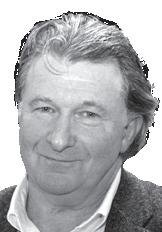
36 IFJ ISSUE 5 2023
In 2021, the UK-based Textile Services Association launched a scheme for recycling textiles used in the hospitality industry. Textile Services Association
Current fiber-to-fiber recycling rates are exceedingly low. Textile Exchange
Devices That Can Extend Health and Profits
By Marie O’Mahony
Global life expectancy has risen to 71.7 years in 2022 (from 64.5 years in 1950) and is set to rise further to 77.3 years by 2050 according to figures from the United Nations Population Division. Access to healthcare and medical advances are key contributing factors with countries spending most on healthcare tending to have higher life expectancies up to 80 years of age. It is worth noting that an exception here is the United States that has the largest spending but a lower life expectancy than many countries spending less.
Textiles play an important role in all aspects of healthcare and this is reflected in the global medical textiles market that is expected to grow at a CAGR of 5.92% between 2023 and 2027 according to Research and Markets, while a separate report by Markets and Markets anticipate that the biomedical textile market alone will reach $20.7 billion by 2027, growing at a CAGR of 6.3%. Fiber, foam and fabric developments are becoming increasingly smart with functionalities that range from sensing and data communication to pain relief and repair. This article looks at three examples of these developments, looking at what they do and why, but also focusing on some of the novel ways that they are using and combining different process including Flexible Hybrid Electronics (FHE), smart yarn and liquid metal foam sensors.
Flexible Hybrid Electronics (FHE) is an area of growing importance for both smart (including medical) textiles and the electronics industries. They allow
for a greater integration of electronics and textiles with the benefit of flexibility, stretchable and conformable. The functionalities they offer include heating, sensing, data gathering and communication, lighting and pain relief. Medical skin patches allow for untethered monitoring of different vital signals such as the heart, using Electrocardiogram (ECG), brain, using Electroencephalogram (EEG), and muscle, using Electromyography (EMG). Quad Industries manufacture electronic skin patches and diagnostic electrodes that are well suited for remote and longterm monitoring of ECG, EEG, EMG
and emotional state using Galvanic Skin Response (GSR) measurements. In addition to monitoring and measurement, electrostimulation can also be incorporated into the patch. Although very slim and flexible, the patch is comprised of multiple layers. Innermost is a sensor dot cradle and snap button, then a textile layer of medical-grade nonwoven followed by a low temperature hotmelt with ultrathin, flexible and stretch thermoplastic polyurethane (TPU) followed by a stretchable conductive silver then dielectric and silver chloride inks. Skin adhesives with hydrogel or dry electrodes are next to the skin with these determined by the use-case and protected by the release liner prior to use. Dry electrode adhesives offer the possibility of wearing the patch for several days, particularly important when dealing with patients with fragile or sensitive skin.
Quad has collaborated with Mentech to apply their technology to a smart sock designed to monitor stress levels in patients who cannot easily express their emotions. Regular wrist monitoring does not work effectively for people with dementia for example, and they are prone to removing or damaging the device. The sock uses an Electrodermal Activity (EDA) sensor with measurements taken by two electrodes connected to two sensor pads placed on the sole of the foot, the area that researchers have found best to measure skin conductivity. A meandering print is used to allow for the stretch needed and avoid damaging the electrodes. A HUME-module is located above the ankle to collect and analyze data and

ISSUE 5 2023 ifj.com 37
MEDICAL TEXTILES
The smart sock from Mentech and Quad Industries uses an electrode patch to measure skin conductance, detecting stress or anxiety in the wearer. Marie O’Mahony
send it via Bluetooth to a device such as a smartphone. The smart sock offers a number of benefits over patches, including the ability to monitor unobtrusively using a familiar piece of clothing, the ability to reuse and its washability.
Smart yarns are being developed that offer an array of functions from monitoring to active healing. These are increasingly fine, offering a more fully contained system significantly reducing, or even eliminating altogether, the need for additional components that add bulk and reduce flexibility and comfort. In a smart yarn development from Volt, part of the Supreme Corporation, nanotechnology
and photomedicine technologies combine to improve the healing speed and process of a wound or infection. The company has worked with the Advanced Functional Fabrics of America (AFFOA) to develop a TTS- Nano-Hybrid LED yarn that uses an AFFOA monofilament embedded with tiny LEDs. Multifunctional nano platform technologies are used to provide theranostic functionalities that pair diagnostic biomarkers with therapeutic agents. A key component is the ability of visible light to activate particular dye molecules to perform certain functionalities.
Principal Scientist Rakkiyappan Chandra describes the impact of the three
different types or infrared radiation on the skin with the shortest wavelength, Near-infrared (NIR) capable of penetrating the skin’s epidermis layer to remove toxins, stimulate skin renewal and tissue growth. Mid-infrared (MIR) is a longer wavelength that can penetrate deeper into the body’s soft tissue where inflammation can occur, there it helps to expand the blood vessels, increasing circulation so that oxygen can reach the injured area and also stimulate the cardiovascular system. The longest wavelength is Far-infrared (FIR), capable of penetrating deep into the body where toxins are stored, using heat to stimulate sweat glands and expel heavy metals and other toxins. The skin has been shown to be an excellent IR emitter, with textiles found to offer low IR transparency and capable of strongly absorbing human body radiation.

Photodynamic Therapy (PDT) dates back to 1900, discovered by Oscar Raab who showed that exposure to light resulted in microorganisms being killed. The difference between many of the therapies already in existence is that this does not need an external light source, usually only available under controlled conditions in a hospital. The TTS yarn operates by harvesting and converting the body’s own heat energy, reflecting it back to the body as light energy. The yarn can be used in medical bandages as well as baselayer garments, socks and gloves forming a Thermoregulating Therapeutic Smart Fabric (TTSF).
Liquid metals (LMs) are attracting attention as a form of soft electronics with good stretch, deformation and durability. Researchers at North Carolina State University and universities in China are developing it as a soft stress sensor. They have outlined their research in a recent paper titled “Breathable encapsulated liquid metal foam-based soft stress sensor” published in Advanced Materials Technologies. “Liquid metals” is the term used to describe liquids that are at or near room temperature. With properties of non-toxicity, they offer high electrical and thermal conductivity. They can be produced as a soft stress sensor either by injecting the LM info an elastomer,
Medical skin patches such as these from Quad Industries, allow for thinner, more flexible and comfortable monitoring of vital signals. Marie O’Mahony
al foil option would not be air or sweat permeable. The fork-like configuration is used to make it easier to insert into the foam. The LM foam (BELMF)-based sensor is intended for applications in human
books on advanced and smart textiles published by Thames and Hudson. She can be contacted at marie.consultant@ gmail.com. www.linkedin.com/in/marie-omahony-94776836
For more than 50 years, Fi-Tech has successfully worked with manufacturers of machines and key techical components used in the production of:



Our customers trust us to provide the best quality and rely on our commitment to their needs when exploring new opportunities to grow and to improve their manufacturing businesses.
Equally, our suppliers highly value the service, dedication, and access to the markets we provide.

ISSUE 5 2023 ifj.com 39
Polymers Synthetic Fibers Nonwovens
fi-tech.com
804-794-9615 sales@fi-tech.com
Let Fi-Tech be “Your Global Connection”
It’s Getting Real The Circular Economy Discussed at Hygienix™2023
Returning to vibrant New Orleans, Louisiana, the city plays host for Hygienix™ 2023, November 13-16, 2023, held at the iconic Roosevelt New Orleans Hotel. INDA, Association of the Nonwoven Fabrics Industry, has once again put together a worthy event, with plenty of tabletop exhibitors and innovative speakers to educate and inspire.


Pre-Show Warmups
The annual conference begins with two pre-conference webinars. Intended to bring the industry together before the live event, the pre-show events are a new place to connect, converse and to gain content. The sessions are:
• Period Products – The New, the Old, and the Old-New, Wednesday, October 25th, 11 a.m. ET, presented by Heidi Beatty, CEO, Crown Abbey, LLC; and
• Global Trends in Diapers, Baby Pants & Adult Underwear , Wednesday, November 8th, 11 a.m. ET, presented by Natalia Richer, COO, and Irene Richer, Market Analyst & Partner, Diaper Testing International SA de CV. Register at www.hygienix.org/preconference-webinars.html. Heidi Beatty’s webinar is complimentary and the Natalia and Irene Richer webinar has a fee of $250 for members and non-members.
At the Show Know Power
Kicking off the event on Monday, November 13 is a training opportunity for those desiring a deeper dive into “Absorption Systems for Absorbent Hygiene Products,” an Essentials Short Course in Nonwovens Workshop from 1 p.m. to 4 p.m. (additional charge applies and space is limited). This classroom discussion with instructor Jim Robinson, Principal, Absorbent Hy-
giene Insights, LLC and fellow attendees focuses on the Components and Interaction of the Absorption Systems, like SAP, Fluff, Adhesives, and Acquisition Layers. Later that evening, from 6:30 p.m. to 8:30 p.m., the Welcome Reception is a perfect opportunity for attendees to meet and greet each other before the meetings officially kick off.
Innovation Power
The first full conference day of Hygienix™ 2023 starts with an in-depth view on AHP Trends, Drivers and Insights, moderated by Nick Carter, Freeze Point Consulting. Other morning presentations include:
• An In-depth Look at the Forces Changing the Industry and the Overlooked Opportunities They Present, with speaker Courtney Scharf, Futurist & Chief Client Officer, Trend Hunter, Inc. She reviews consumer behavior-based megatrends, how to utilize them in innovation, and how you can expect them to evolve in the future.
• Accelerating Innovation Embracing a Consumer-Centric Approach, with presenter Ashish Chatterjee, Principal, INNOVATEGRN and Entrepreneur in Residence, Cintrifuse. She’ll look at sustainable fibers in hygiene innovation, in light of pressure that consumers are not willing
to pay more for green products. She also highlights consumer-centric innovation and accelerated innovation cycles, allowing industry to embrace relevant megatrends including personalization, sustainable lifestyle, and health & wellness sooner with viable solutions.
• Spiraling into Business: How a Dramatic Innovation to the Tampon Met the World’s Largest Manufacturer of Feminine Hygiene Products, with Sequel CEO & Co-founder Greta Meyer and Shlomo Helvits, Technical Manager, Albaad Fem. They discuss how the small California startup uniquely entered a strategic partnership with one of the world’s largest tampon manufacturers, and the teamwork that brings new energy to a space that is ripe for disruption.
Shifting the focus to the viability of the circular economy in the afternoon, some of the sessions are:
• A panel discussion on Navigating Consumer Voice, Sustainable Innovations and the Circular Economy, moderated by Richard Koefler, CEO, SynTouch, Inc.;
• Sustainability and Circularity in Absorbent Hygiene Products Industry with Chirag Virani, Co-Founder and CEO, Sparkle Innovations Inc.; and,
• Increasing Plastics Circularity for the Hygiene Segment Through Advanced Recycling, with Christy Sapp, Strategic Feedstock Sourcing Director, Nexus Circular.
Talking in Circles
Day two brings more information, education and inspiration starting with a panel on the Possibilities of Closed Loop Circularity, moderated by Heidi Beatty, CEO, Crown Abbey, LLC.
Other presentations of the day include:
40 IFJ ISSUE 5 2023
SHOW PREVIEW
• Squaring the Circle: Why Demonstration Projects = Good Sustainability Strategy with Colin Alexander Hanna, Director of Market Research, Price Hanna Consultants; and
• Closing the Circularity Gap One Used Pad at a Time with Penelope Finnie, CEO, Egal Pads, Inc.

Sessions continue into the afternoon, with key topics such as Sustainability Inputs and Packaging; Bio-based and Biodegradable Superabsorbent for Hygiene Products; Consumer Mindsets; and Wellness and Natural Materials; Hybrid Products; Flushability, and more.

Show Features
Throughout the show, attendees will be treated to networking breaks, award presentations, and a popular feature – Lightning Talks from various vendors of the exposition. The nightly Tabletop Exhibits with Reception are a great place to discuss the day with colleagues. The exciting Expo will host vendors who are pivotal to take your concepts and company to the next level. You won’t want to miss out on these valuable new and renewed connections!
Backdrop
If all that was not enough to entice you to Hygienix, New Orleans is known as the foodie capital of the U.S. The Hygienix experience will feed your mind … and your stomach. The historic city was designated as the Best Food Destination in the United States in the 2023 Travelers’ Choice Awards, TripAdvisor, 2023. For history buffs, the city is also home to the The National WWII Museum, which is hosting a special exhibit highlighting Disney’s 100th Anniversary, “The Walt Disney Studios and World War II,” which explores how one of America’s most beloved entertainment companies helped achieve Allied victory.
For hygiene professionals, the real victory is attending the show and walking
Award-Winning Ideas on Display
away with new ideas for segment growth and an edge on the competition, learning from the excellent lineup of speakers, sessions, and exposition participants. www.hygienix.org
The HYGIENIX Innovation Award™ recognizes and rewards innovation within the entire disposable absorbent hygiene value chain that utilizes nonwoven fabric or technology in a way that expands the usage of nonwovens. Presented annually at the HYGIENIX™ Conference, eligible categories include, but are not limited to: raw materials, roll goods, converting, packaging, active ingredients, binders, additives and end-use products. This year’s contenders are:
Glatfelter:
GlatPure™
GlatPure™ is a range of bio-based absorbent hygiene components derived from renewable materials. This product range consists of a variety of plant-based and natural topsheets, an acquisition distribution layer, an absorbent core, a newly improved backsheet, and a landing zone. Crafted from 100% renewable fibers and biodegradable materials, and enriched with bio-based binders, GlatPure™ stands as the industry’s first fully functional, fossil-fuel free range of solutions.
Mundao: Diap’Earth®
From nature to nature: Mundao brings onto the market DIAP’EARTH®, an industrially compostable disposable baby diaper as a solution to AHP waste problem for a clean, useful and circular end of life. Ecoconception (DIAP’EARTH is the most biobased and plastic free diaper on the market) makes it possible to compost it in an industrial composting facility to bring back carbon to soil and fertilize it. DIAP’EARTH is successfully used and composted in major French cities.
Sequel: The Sequel Spiral™ Tampon
The Sequel Spiral™ Tampon features a proprietary spiral design that is engineered to be more fluid mechanically efficient, meaning it is designed to absorb more evenly and not leak before it’s full. In August 2023 the Sequel Spiral™ Tampon received clearance from the United States Food and Drug Administration (FDA) as a medical device and the company will now begin a series of consumer trials, with broad availability expected in Q1 of 2024.
ISSUE 5 2023 ifj.com 41
ITMA ASIA + CITME is On Target for a Large, Vibrant Show
ITMA Services. Online visitor registration is now open. To register or for more information, please visit www.itmaasia.com.
2024 Announced
ith the Asian marketplace back to business as usual, the enthusiasm is high to return to the rescheduled ITMA ASIA + CITME. As Asia’s leading business platform for textile machinery, the show continues to draw interest for its exhibition. Now taking place from November 19 to 23, 2023 in Shanghai, the event expects to have almost 1,500 exhibitors from 24 countries and regions taking part in the combined exhibition.
Six exhibition halls of the National Convention and Exhibition Center grossing over 160,000 square meters have been booked, according to the show owners –CEMATEX and its Chinese partners, the Sub-Council of the Textile Industry, CCPIT (CCPIT-Tex), China Textile Machinery Association (CTMA) and China Exhibition Centre Group Corporation (CIEC).
Exhibitors are also buoyant about prospects as China’s economy is projected to be performing better than expected. The International Monetary Fund (IMF) recently revised its forecast for China’s GDP growth upwards to 5.2% in 2023 from its previous projection of 4.4% last October.
“The reopening of China’s economy is pivotal for the region as China is a key driver of the expansion. Such positive news has helped textile machinery manufacturers to rebuild their confidence in the China market,” explained Ernesto Maurer, President of CEMATEX, which owns the ITMA

and ITMA ASIA exhibitions. “We salute our exhibitors for keeping faith with us,” he added. “Not only have they not withdrawn their participation, but some have also even increased their booth space.
Gu Ping, President of China Textile Machinery Association, said, “Compared with the previous combined exhibition, the number of exhibitors in this edition has increased by 15 percent. We welcome the presence of these new enterprises as they will add to a more diverse showcase of the technological innovation, and provide new vitality and impetus for the development of the textile industry.”
Many exhibitors have also increased their booth space after China eased its strict COVID rules and reopened its borders earlier this year. Among the exhibitors who have increased their space since the Chinese government’s announcement early this year are Muratec, Saurer, Savio, TMT Machinery and Trützschler.
“We have decided to enlarge our booth space because our outlook for the Chinese market is very positive, and we expect more overseas visitors now,” said Harald Schoepp, Managing Director of Trützschler China. “We are going to present Trützschler’s latest machinery and solutions for the spinning, nonwoven and man-made fiber industries.”
The combined show is organized by Beijing Textile Machinery International Exhibition Co., Ltd., and co-organizer
The show recently announced dates for next year: October 1418, 2024, at the National Exhibition and Convention Center, Shanghai, China.
In making the announcement ahead of the 2023 show, Ernesto Maurer explained, “The planning of the 2024 edition of ITMA Asia + CITME requires an exceptional process, starting already ahead of this year’s edition in November 2023. The exhibition has a stringent admission policy which encompasses various processes, including various stages of space application, rigorous admission procedures, space allocation, and thorough booth design vetting. Considering the multifaceted aspects involved in these preparatory stages, and above all, to safeguard the quality of the 2024 edition of ITMA Asia + CITME, the stand space application must open well ahead of the show in October 2024.”
Gu Ping said, “I believe the launch of ITMA Asia + CITME 2024 as scheduled next year, will be a highly anticipated event to foster greater collaboration and exchanges between domestic and foreign textiles industries, working together to shape the future.
For more information on ITMA ASIA + CITME 2023 and 2024, please contact: Daphne Poon, ITMA Services, at +65 94789543 and via email at daphnepoon@ itma.com. You can also reach out to Christine Tang, Beijing Textile Machinery International Exhibition Company, at + 86 10 85229646 and via email at Email: tangrong@ccpittex.com

42 IFJ ISSUE 5 2023
W
SHOW PREVIEW 19-23 November 2023 I Shanghai, China ITMA Asia
By Seshadri Ramkumar, Ph.D.
Nonwovens and Advanced Materials Laboratory, Texas Tech University
Seshadri Ramkumar, Ph.D., is professor of nonwovens and advanced materials at Texas Tech University. He is a member of Technical Advisory Board at INDA, Association of the Nonwoven Fabrics Industry. He was the immediate past chair of the Nonwovens Engineers & Technologists (NET) Division of TAPPI, and he publishes a column called TexSnips. He can be reached at s.ramkumar@ttu.edu.

Advanced Textiles Moving Forward
ight years ago, world nations came together and adopted Sustainability Development Goals (SDG). Aimed at battling global poverty, climate change and focus on economic development in a sustainable way, there are 17 goals, which are termed as SDG.
Adopting some goals listed in SDG offers challenges and at the same provides opportunities. Textile materials, particularly advanced textiles like nonwovens, composites and hybrid material, can find many applications related to goals adopted by the United Nations, such as infrastructure development.
Scientific and technological developments taking place in infrastructure, transportation, medicine, agriculture, and environment sectors, are pushing the textile sector to be innovative and nimble.
Adversity Enabling the Growth
COVID-19 has provided great opportunities and challenges. Nonwoven-based healthcare and hygiene products like breathable viral barrier protective gowns, medical drapes, hospital bedsheets, medical and non-medical surgical masks, filtering facepiece respirators such as R95 and N95 were in the limelight and were used immensely. This is a positive factor for the textile sector as advanced textile products have become daily kitchen table discussion points, bringing enormous attention and visibility to textiles. Such an impactful scenario is needed to revive the manufacturing sector in the United States and other developed economies.
The Biden Administration’s American Rescue Plan is enabling the revival of textile manufacturing such as manufacturing of defense, medical and protective textiles at companies such as Auburn Manufacturing in Maine, to name a few. While the above scenario is a positive aspect for manufacturing, it also exposed vulnerabilities such as the dependency on imported textiles, the overcapacity in the manufacturing of commodity textiles such as spinning in leading textile manufacturing countries, and the need for new and functionalized raw materials from fiber to finish. Research and development, as well as large scale manufacturing of advanced and niche products will take the industry to the next phase.
Innovation: A Way Forward
With sustainability rightly taking the front seat, interest in natural fiber-based advanced textiles, functionalization of textiles using environmentally friendly chemicals, scaling up of greener
technologies and processing methods like wider width plasma finishing, nano metal oxide-based additive manufacturing, etc., offer immense promise.
Linkages Are Important
The textiles sector has realized the need to revitalize and must focus on greater R&D investments, skill development, industry-academia collaborations, and multinational partnerships. More importantly, while domestic manufacturing needs support and revival, targeted trade agreements will enable enhanced marketing opportunities.
Small and medium scale enterprises (SMEs) can benefit more by B2B linkages, enabling increased opportunities for R&D intensive advanced textiles that will create high paying jobs and greater marketing opportunities. SMEs can benefit by sponsoring research in academia, licensing inventions from federal laboratories and research-intensive universities. Such linkages offer win-win advantages for SMEs and universities as universities benefit by transferring laboratory ideas to the marketplace with the help of industry. Academia can avail access to contract research. Linkages with chambers of commerce, economic development organizations and local governments can spearhead economic growth and job creation. Opportunities are plenty for personnel protective equipment manufacturers and natural fiber producers such as cotton, hemp, and flax, to name a few.
A case in point is the successful collaboration between Chantilly, USA-based First Line Technology, Hobbs Bonded Fibers, a nonwoven manufacturer, and Texas Tech University. This collaborative endeavor first resulted in a defense product, which is a non-particulate toxic chemical decontamination wipe. However, due to the continued efforts of First Line Technology, the nonwoven wipe technology has transferred into a wipe that can absorb opioid products leading to life saving measures. Such developments can happen due to collaborative efforts and greater support from the industry.
The way forward for the textile sector is to look forward to finding multisector applications, academia-industry relationships, and international linkages. As the sector is facing a multitude of regulations, support and advocacy efforts by global policy agencies and industry associations such as INDA are vital more than ever. Advanced and sustainable manufacturing is the path of the future for the nonwoven and advanced textiles sector.
ISSUE 5 2023 ifj.com 43
TECH TALK E
Avoiding Common Traps and Mistakes When Deciding to Sell Your Company in a “Recession”
By Len LaPorta Managing Director of Investment Banking, Wiley Bros.-Aintree Capital, LLC

Len LaPorta is a managing director of Investment Banking at Wiley Bros.-Aintree Capital, LLC – a 75-year-old firm, located in Nashville, TN, focused on investment brokerage and underwriting municipal bonds for utility districts in the state of Tennessee. Len brings to the Firm experience in crossborder M&A transactions between USA and Europe, advises business owners on sell-side and buy-side transactions, capital advisory, and valuations. Len is a graduate of the U.S. Naval Academy with MBA from Boston College and a veteran of the U.S. Navy. He is also a member of INDA’s non-woven Technical Advisory Board. llaporta@wileybros.com or (615) 782-4107.
Many readers of my column have become accustomed to hearing on a daily and weekly basis, discussions of an imminent recession, of which business owners should be highly concerned.
Initially, the recession pundits estimated January/February 2023 as the timeframe for the onset of the recession. This resulted in many business owners hitting the pause button on capital expenditures or putting a new strategic initiative on hold.

The markets weathered January/February 2023 and heading into March/April 2023 timeframe, the same pundits who previously touted a recession, were amazed as to how many companies reported
strong Q1 2023 financial performance. Recognizing that some industries have struggled, but in my sphere, a majority of companies started the year very well. Many companies showed a much stronger YTD 2023 versus 2022.
The other day in front of the television, it was amazing how many of our gurus are very confident that a recession will happen in “late 2023.” It turns out that Q1 2023 had a strong showing across many sectors.
Hopefully, most of you were able to avoid being in the sand trap for the first 180 days of 2023. Seeking good advice is key when considering or embarking upon a transaction. Often such advice is not found on the news. Maybe it is time for you to engage an investment banker who can examine your business relative to the overall market landscape – your company valuation upon exit might just surprise you.
This article has been prepared solely for informational purpose. This article does not constitute an offer, or the solicitation of an offer, to buy or sell any securities or other financial product, to participate in any transaction or to provide any investment banking or other services, and should not be deemed to be a commitment or undertaking of any kind on the part of Wiley Bros. –Aintree Capital, LLC (“WBAC”) or any of its affiliates to underwrite, place or purchase securities or to provide any debt or equity financing or to participate in any transaction, or a recommendation to buy or sell any securities, to make any investment or to participate in any transaction or trading strategy. Any views presented in this article are solely those of the author and do not necessarily represent those of WBAC. While the information contained in this commentary is believed to be reliable, no representation or warranty, whether expressed or implied, is made by WBAC, and no liability or responsibility is accepted by WBAC or its affiliates as to the accuracy of the article. Prior to making any investment or participating in any transaction, you should consult, to the extent necessary, your own independent legal, tax, accounting, and other professional advisors to ensure that any transaction or investment is suitable for you in the light of your financial capacity and objectives. This article has not been prepared with a view toward public disclosure under applicable securities laws or otherwise.
44 IFJ ISSUE 5 2023
M&A INSIGHTS
Federal Reserve Dallas. June 2023. Merchandise Exports to World.
Since Fall 2022, our business leaders have continued to hear the word “recession” and this single word has led to many mistakes impacting value.
Seeking good advice is key when considering or embarking upon a transaction. Often such advice is not found on the news.

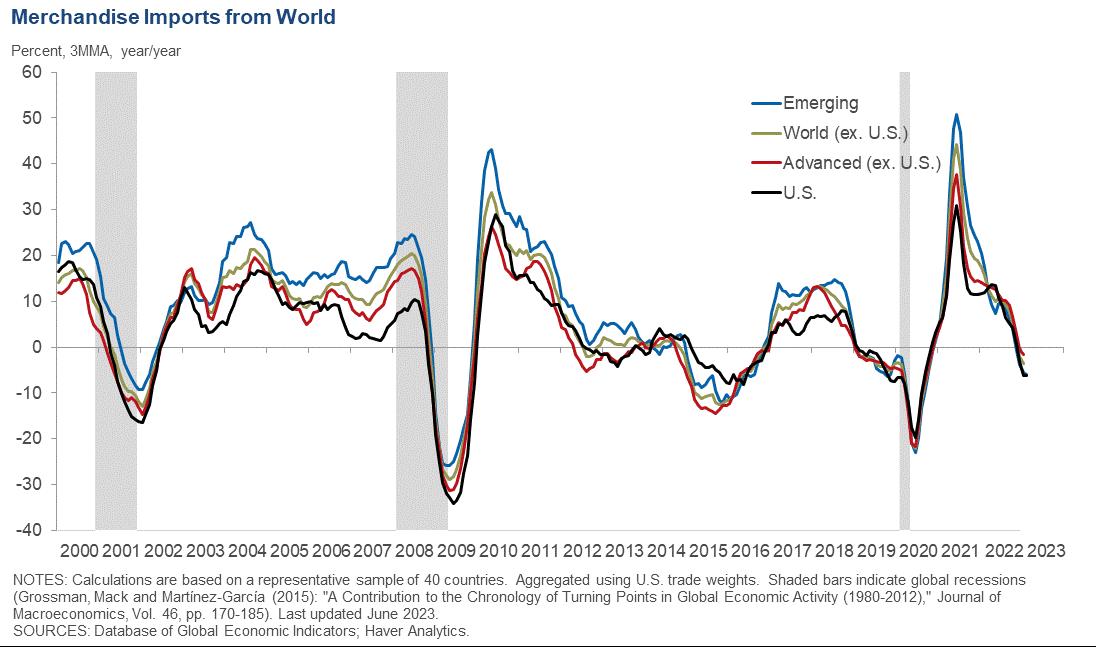
ISSUE 5 2023 ifj.com 45
Federal Reserve Dallas. June 2023. Merchandise Imports from World Federal Reserve Dallas. June 2023. Core CPI Inflation (Excluding Food and Energy).
Roth Composite Machinery Celebrates Double Anniversary

Schlesinger were merged and renamed “Roth Composite Machinery.” Since then, under the motto “Your Performance –made by Roth,” Roth Composite Machinery has stood for machine concepts that are individually adapted to customer needs. www.roth-composite-machinery.com
Spinnova and Renewcell Announce Cooperation to Scale Circular Fashion
Roth Composite Machinery recently celebrated a double anniversary with festivities for the employees at all three locations: 60 years of filament winding expertise going back to the original company Bolenz & Schäfer, and 40 years of coating expertise of the original company EHA. “Today we look back on a total of 100 years of curiosity, innovative strength and skill,” said Managing Director Dr. Andreas Reimann.
Roth Composite Machinery came from the merger of three long-established companies. Since 1963, research and development has been carried out in the field of filament winding technology at the former company Bolenz & Schäfer in Biedenkopf-Eckelshausen. “An absolute future technology in which we are a globally recognized and sought-after player thanks to our decades of expertise,” said Dr. Reimann.
While Bolenz & Schäfer was driving expertise in filament winding, the company EHA in Steffenberg was involved in special coating technologies. EHA was founded in 1983 and became part of the Roth Industries Group in 1995. Bolenz & Schäfer had already become part of the Roth Group in 1989 and, like EHA, initially continued to operate under its own name. In 1999, Bolenz & Schäfer’s filament winding special machinery business was transferred to EHA. In 2016, EHA and the Burgwald-based company
Spinnova, the sustainable textile material company, will partner with Swedish textile recycling innovator Renewcell to develop and promote a concept to commercialize and scale textile waste-based fiber. The collaboration is the first of its kind, where textile waste-based fiber can be spun into new fiber without harmful chemicals. The first consumer products from this new textile fiber are estimated to be available by the end of 2024.
create man-made cellulosic fibers, such as viscose. With Spinnova’s transformative technology, the partners can turn CIRCULOSE® into a new, biobased textile fiber without any harmful chemicals in the fiber spinning process.
Spinnova has already made successful trials spinning the CIRCULOSE® pulp into new textile fiber. The first batches of SPINNOVA® fiber made with 100 % CIRCULOSE® have been produced for yarn and fabric development, and the first prototypes are made from a blend of cotton and SPINNOVA® fiber made with CIRCULOSE®. www.spinnova.com
Santoni Shanghai Knitting Machinery Co., Ltd., Acquires Terrot GmbH

Santoni Shanghai Knitting Machinery Co., Ltd., founded and wholly owned by Italy’s Lonati family, announced the strategic acquisition of Terrot GmbH, a leading manufacturer of circular knitting machines based in Chemnitz, Germany. The move comes as the latest development in Santoni Shanghai’s long-term vision to build an ecosystem that aims to reshape and consolidate the circular knitting industry. The transaction will be finalized pending approval from Chinese regulatory authorities.
Award-winning circular innovation companies Spinnova and Renewcell announced their cooperation to introduce a technology concept for scaling the production of next-generation textile fiber from textile waste. The new fiber production concept combines patented technology from both companies and advances the circularity in the fashion and textile industries.

Pioneering a circular economy in the fashion industry, Renewcell recycles cellulosic-rich textile waste such as cotton and viscose using a patented process, which transforms textile waste into a pulp product called CIRCULOSE®. This biodegradable raw material is produced from 100% recycled textiles and can be used to create new fibre. Until now, CIRCULOSE® has been used to
The global circular knitting machine market is expected to see significant growth in the coming years, with a July 2023 report from Consegic Business Intelligence forecasting a 5.7% CAGR from 2023 to 2030, propelled by an increasing consumer preference for breathable and comfortable knitted fabrics as well as increasingly diversification of demand for knitted apparel. To seize this market opportunity, Santoni Shanghai has developed an ambitious strategic plan centered around innovation, sustainability and digitalization. The new partnership with Terrot aims to further this strategy by enhancing Santoni’s integrated and
46 IFJ ISSUE 5 2023
MOVERS & SHAKERS
The double anniversary brings the total to 100 years of experience and skill: On behalf of the Roth Industries Group, CEO Matthias Donges (right) and shareholder Christin Roth-Jäger (2nd from right) presented a congratulatory plaque to Roth Composite Machinery Works Council Chair Simone Leschhorn and Managing Director Dr Andreas Reimann. Roth Composite Machinery
Spinnova fibers. Spinnova
scaled-up ecosystem, while also driving the sustainable development of the global knitting machinery industry. www.santoni.cn
Textil Santanderina Launches
Authentic Black Denim Collection
Based on DIRESUL®
Textil Santanderina, an innovator known globally for the manufacture of quality fabrics with controlled traceability, recently launched its Advanced Black denim collection in collaboration with Archroma,

the synthesis process is reduced by 73% for massive savings. The new DIRESUL dyestuff, when adopted with the full Archroma coloration system, delivers a new black color with on-tone wash-down effect and cleaner effluent at the mill. www.archroma.com
Standard Textile Welcomes
Jonathan Simon as EVP
Standard Textile Co., Inc., a global leader in the healthcare and hospitality textile markets, announced the appointment of Jonathan Simon as its new Executive Vice President of Global Growth & Strategy. Simon will play a key role in guiding the company’s vision and overseeing the development and implementation of global growth strategies and initiatives. Simon’s deep global industry experience will offer a broad perspective, setting the stage for an exciting phase of growth and success for the company.
Bally Ribbon Mills Supplies E-WEBBINGS® E-textiles for Torabhaig Atlantic Explorer Gas Balloon
a global leader in specialty chemicals towards sustainable solutions.

The Advanced Black collection by Textil Santanderina uses Archroma’s new DIRESUL® EVOLUTION BLACK LIQ dyestuff to produce on-trend authentic black denim apparel with industry-leading sustainability and resource savings. In addition to allowing fashion and apparel brands to choose eco-friendlier alternatives that demonstrate their commitment to protecting people and planet, Textil Santanderina’s new Advanced Black denim range also offers unique shade and wash-down effects for heightened consumer appeal.
Based on cutting-edge synthesis technology developed by Archroma, DIRESUL EVOLUTION BLACK LIQ delivers an overall impact reduction to 57%*, measuring its effect on human health, ecosystems and resources compared to standard Sulfur Black 1 liquid. Unlike traditional synthesis processes, it does not produce any ammonia, sodium salts waste or liquid effluents, and water consumption in
“We are thrilled Jon is joining Standard Textile,” Gary Heiman, Chairman and CEO of Standard Textile says. “I have known Jon for over twenty years and have been impressed by his humble leadership, innovative mindset, and relentless focus on future growth. Jon is a proven leader with the vision to expand the success we have built over the past 83 years and take us into a new phase of growth and innovation.”
Simon brings significant global experience in corporate strategy, manufacturing, product development, and sales and marketing in the industrial and retail textile industries. In his most recent role as CEO of 1888 Mills, Simon provided inspired leadership for all aspects of the company’s operations while working with the executive board to establish short and long-term goals and related plans and policies. Simon resigned as CEO of 1888 Mills in December of 2020 to serve on its board. Simon’s impressive track record of driving revenue and market share growth, as well as his ability to build and foster meaningful and trusting relationships, has set him apart as a leader in the industry.
www.standardtextile.com
Bally Ribbon Mills (BRM), an industry leader in the design, development, and manufacture of highly specialized engineered woven fabrics, announced it provided E-WEBBINGS® e-textiles to Best Aviation Services. Inc., the balloon manufacturing and repair company supplying a tension system to support the Torabhaig Atlantic Explorer gas balloon’s open basket as it prepares to take the first flight across the Atlantic in an open basket gas balloon. The innovative design incorporates electronic components used to dissipate static electricity. The balloon will take off from Maine and then fly over Newfoundland before crossing the Atlantic and landing in Europe.
The new design was critical to meeting the very tight manufacturing timeline by reducing the project’s Bill of Materials and saving Best Aviation hundreds of hours of additional sewing. Bert Padelt, owner of the Bally, Pennsylvania-based balloon manufacturing and repair company, said, “Because of your design and quick turn-around on this R&D work, we were able to meet our tight deadline and launch window schedule.”
The Torabhaig Atlantic Explorer, piloted by UK-based Sir David HemplemanAdams, will collect air samples to look for new scientific discoveries. Sir Hempleman-Adams will be accompanied by Bert Padelt and Swiss explorer, scientist and entrepreneur, Dr Frederik Paulsen. The journey is expected to take four to five days, flying at an altitude of 6,000 to 8,000 feet. It would be the first Atlantic crossing in a hydrogen balloon and may also mark the longest distance covered in this type of balloon. www.ballyribbon.com
ISSUE 5 2023 ifj.com 47
Textil Santanderina authentic black denim collection based on Archroma’s eco-advanced DIRESUL® EVOLUTION BLACK sulfur dyestuff.
Orion S.A. Investing €12.8M in Project for Circular Carbon Black
Orion S.A., a global specialty chemicals producer, is investing €12.8 million – including €6.4 million in funding from the German government and European Union – to further develop and demonstrate a climate-neutral process for producing carbon black from alternative carbon sources, the company said.
The technology is designed to improve Orion’s yield and throughput in the production of carbon black using circular feedstocks and thus potentially reduce the carbon footprint of the process. This could accelerate the shift to a circular economy and feed the growing demand for sustainable materials in the tire industry.
Half of the €12.8 million Orion plans to invest in this initiative, called the “Clean Carbon Black Research and Development Project,” will be provided by the decarbonization program of Germany’s Federal Ministry of Economic Affairs and Climate Action, supported by the EU’s NextGenerationEU fund.
www.orioncarbons.com
AD SALES
ADVERTISING | SALES
PUBLISHER Driven By Design LLC
advertising@inda.media • +1 239.225.6137
Sabine Dussey
GERMANY, FRANCE, AUSTRIA, SWITZERLAND, SCANDANAVIA, BENELUX sabine.dussey@dussey.de • +49 2129.348390
Joan Oakley BUYER’S GUIDE & CLASSIFIED ADS joakley@inda.media • +1 248.347.3486
Ferruccio Silvera & Filippo Silvera ITALY & SPAIN info@silvera.it • +39 02.284.6716
Frank Strazzulla UNITED STATES +1 949.459.1767 • franks@tmsmedia.net
Zhang Xiaohua CHINA ifj_china@126.com • +86 13522898423
ADVERTISING COORDINATOR VICKIE SMEAD vsmead@inda.org • +1 919 459 3700 x 3720
Kelheim to Present Sustainable Innovations at GFC
Kelheim Fibres, a leading manufacturer of specialty viscose fibers, will showcase its latest developments at this year’s Global Fiber Congress in Dornbirn. The focus is on innovative solutions that not only promote environmental sustainability but also strengthen the European supply chain.
In the presentation “Towards high performing plant-based AHP products – a joined approach of Pelz and Kelheim Fibres,” Dr. Ingo Bernt, Project Leader of Fiber & Application Development at Kelheim Fibres, together with Dr. Henning Röttger, Head of Business Development at PelzGROUP, will introduce the development of a plastic-free yet highperformance panty liner. The water-repellent Kelheim specialty fiber Olea plays a crucial role in both the top and backsheet of the panty liner. This product emerged from the ambition to offer eco-friendly alternatives to conventional disposable hygiene solutions without compromising product performance.
A similar approach is pursued in the second presented project – but Kelheim Fibres takes it even further. Under the title “Performance Fibres Meet Sustainable Design –example of a reusable Baby Diaper,” Natalie Wunder, Project Leader from Kelheim Fibres’ New Business Development team, together with Caspar Böhme, Co-Founder of Sumo, will introduce the washable and reusable SUMO diaper. Made from biobased materials and featuring a unique construction with Kelheim specialty fibers, this combination offers double environmental benefits compared to conventional disposable baby diapers. www.kelheim-fibres.com
Space Application for ITMA Asia + CITME 2024 Opens
ITMA ASIA + CITME 2024 space application is now open. Asia’s leading business platform for textile machinery will be held October 14-18, 2024, at the National Exhibition and Convention Centre, Shanghai, China.
The regular biennial sequence of the ITMA Asia + CITME exhibition was disrupted due to the global COVID-19 pandemic. Originally slated for 2022, the exhibition had to be rescheduled to 2023. The ITMA Asia + CITME exhibition uniquely combines the Asian edition of the renowned ITMA exhibition with the China International Textile Machinery Exhibition (CITME). Over the past eight editions, it has established a stellar track record and holds significant importance within the textile and machinery industry. www.itmaasia.com/shanghai2024/

48 IFJ ISSUE 5 2023
Inquire Today for the 2024 Media Kit! Email advertising@inda.media
ADVERTISER WEB PAGE Beijing Chonglee chasemachine.com BC Chase Machinery & Engineering ctamp.com.cn 4 DM&E Corporation dmecutter.com IFC Fi-Tech fi-tech.com 39 ILJIN A-TECH CO.LTD iljinat.co.kr 3 INDA hygienix.org 29 ITMA ASIA & CITME itmaasia.com 5 Mozart AG mozart-blades.de 1 Polytex polytex.cc IBC ProMach promachbuilt.com 13 SAHM Winding Solutions starlingersahm.com 17
IFC = Inside Front Cover | IBC = Inside Back Cover | BC = Back Cover
ADVERTISER INDEX
MOVERS & SHAKERS
ITMA Asia + CITME show floor.
PET/PBT/PBAT/PBS/PTT/PLA/PETG/PC/PA6/PA66..
POLYMERS RECYCLING

POLYMER: Physics / Chemistry
GAS & COAL CHEMICAL
BDO/EG/MeOH/Heat recovery and comprehensive u�liza�on
HP
Hydrogen Peroxide, H2O2
R&D
Own R&D Center and pilot plant
ENGINEERING
Project EPC Contrac�ng (Turn-key)
EQUIPMENT TECHNICAL SERVICE
Manufacturing of Cri�cal Equipment
POLYTEX is a professional chemical engineering company and technology supplier integra�ng R&D, engineering, equipment manufacturing, procurement and EPC management services. From technology licensing, project planning, equipment manufacturing and engineering design, procurement and construc�on management, as well as start-up and opera�on services, Polytex provides diversified services and one-stop solu�ons to customers all over the world.
POLYTEX ENGINEERING GROUP

Corp: 5th Floor, No.20 Wenchang Mid Rd. Yangzhou, Jiangsu, PRC.

Head: No.1, Private Industrial Park, Yuetang, Yizheng, Jiangsu, PRC.

Tel: +86-514-85553618; +86-514-87859276
Mail: market@polytex.cc; polytex@vip.sohu.com

Website: www.polytex.cc
24/7 Technical Support & Service
EPLASTMER NEW MATERIAL CO., LTD
Bo�le grade, Tex�le grade, Film grade PET chips will be launched soon. Our own factory capacity in phase-1st will reach up to 1260 tons per day.

China Sales:
Mr Sun Mob: +86-133 1990 0139; Email: sg_sun@e-plastmer.com
Mr Cao Mob: +86-181 5290 1436; Email: cao@e-plastmer.com
Ms Pu Mob: +86-185 0992 5214; Email: pu@e-plastmer.com
Russia and Central Asia Sales:
Mr Li Mob: +86-189 5105 3772; Email: �ger@e-plastmer.com
Mr Gao Mob: +86-138 5159 0251; Email: gaocx@e-plastmer.com
Mr Dos Mob: +86-135 1991 0418; Email: dos@e-plastmer.com
Other markets:
Ms Emma Mob: +86-158 9939 1075; Email: emma@e-plastmer.com
EPC CONTRACTOR WWW.POLYTEX.CC Nov 2023 Shanghai • China Visit POLYTEX at booth H6D27
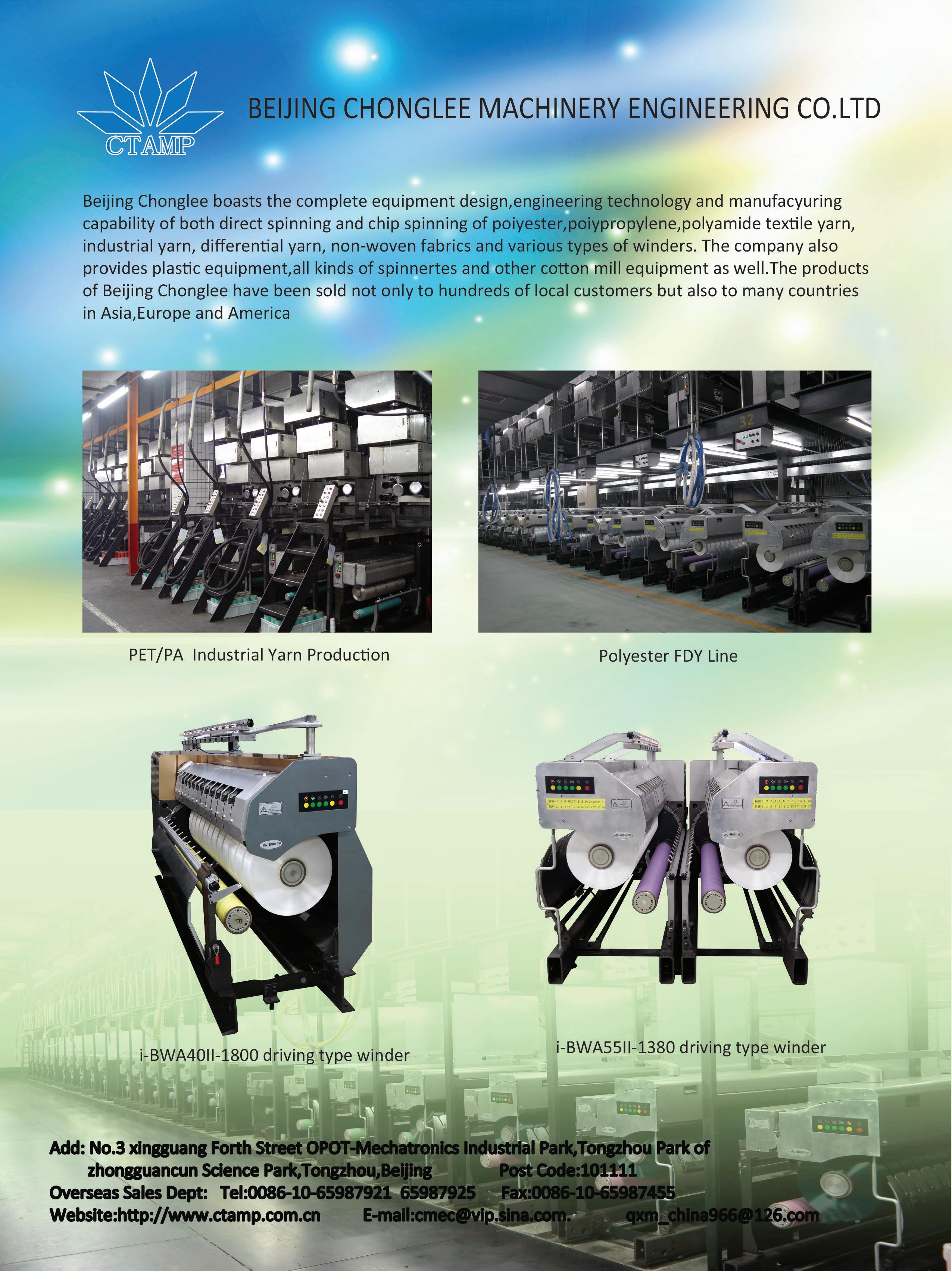
Add: No.3 xingguang Forth Street OPOT-Mechatronics Industrial Park, Tongzhou Park of zhongguancun Science Park, Tongzhou, Beijing Overseas Sales Dept: Tel:0086-10-65987926 65987925 Website:http://www.ctamp.com.cn Post Code:101111 Fax:0086-10-65987455 E-mail:bizlee@126.com








 By Geoff Fisher, European Editor, IFJ
By Geoff Fisher, European Editor, IFJ

























































































































 By Caryn Smith
By Caryn Smith



















































































